Physical Address
304 North Cardinal St.
Dorchester Center, MA 02124
The oral cavity represents the entrance to the upper aerodigestive tract, which begins at the lips and ends at the anterior surface of the faucial arch. It is lined by squamous epithelium with interspersed minor salivary glands. The oral cavity also contains the dentoalveolar structures with the upper and lower dentition. The oral cavity is continuously exposed to inhaled and ingested carcinogens, and thus it is the most common site for the origin of malignant epithelial neoplasms in the head and neck region. Known carcinogens for oral cavity carcinoma include those present in tobacco, alcohol, and betel nuts. The association of human papilloma virus with oral cancer is not as well established as in oropharyngeal cancers.
Primary tumors of the oral cavity may arise from the surface epithelium, minor salivary glands, or submucosal soft tissues. Lesions of dentoalveolar origin represent a unique group of neoplasms and cysts (discussed in Chapter 16 ). The various anatomic sites within the oral cavity as described by the American Joint Committee on Cancer (AJCC) and International Union Against Cancer (UICC) staging system are shown in Fig. 8.1 . More than 90% of malignant tumors in the oral cavity are squamous cell carcinomas, and the remainder are minor salivary gland carcinomas and other rare tumors. The worldwide incidence and mortality of oral cancers in men and women is shown in Figs. 8.2 and 8.3 . Most patients with cancer in the oral cavity are men, although the incidence of tongue cancer in women in the United States has progressively increased over the past several decades. In the Western world, the tongue and floor of the mouth are the most common sites of origin for primary squamous cell carcinomas in the oral cavity. However, the retromolar trigone and buccal mucosa are the most frequently encountered primary sites in areas of the world where chewing of tobacco and/or betel nuts is common. The site distribution of various primary cancers in the oral cavity in the United States is shown in Fig. 8.4 .
The clinical features of the primary tumors arising from the mucosal surface of the oral cavity are variable. The tumor may be ulcerative, exophytic, or endophytic. The gross characteristics of the lesion are usually sufficient to raise the index of suspicion regarding the need for a biopsy to establish tissue diagnosis. Ulcerative lesions usually are accompanied by an irregular edge and induration of the underlying soft tissues ( Fig. 8.5 ). On the other hand, exophytic lesions may present either as a cauliflower-like irregular growth or as flat, pink to pinkish-white proliferative lesions ( Figs. 8.6 and 8.7 ). Occasionally, a red to pink velvety flat lesion is the only manifestation of superficially invasive or in situ carcinoma ( Fig. 8.8 ). Squamous cell carcinomas with excessive keratin production and verrucous carcinomas present as white heaped-up keratotic lesions with varying degrees of keratin debris on the surface ( Figs. 8.9 through 8.11 ). Papillary projections often are seen in lesions that are accompanied or preceded by a squamous papilloma ( Figs. 8.12 and 8.13 ). Compare the appearance of a papilloma to papillary polypoid squamous cell carcinoma, shown in Fig. 8.14 . Bleeding from the surface of the lesion is a characteristic of malignancy and immediately raises suspicion for a neoplastic process. Endophytic lesions have a very small surface component but a substantial amount of soft-tissue involvement beneath the surface ( Fig. 8.15 ).
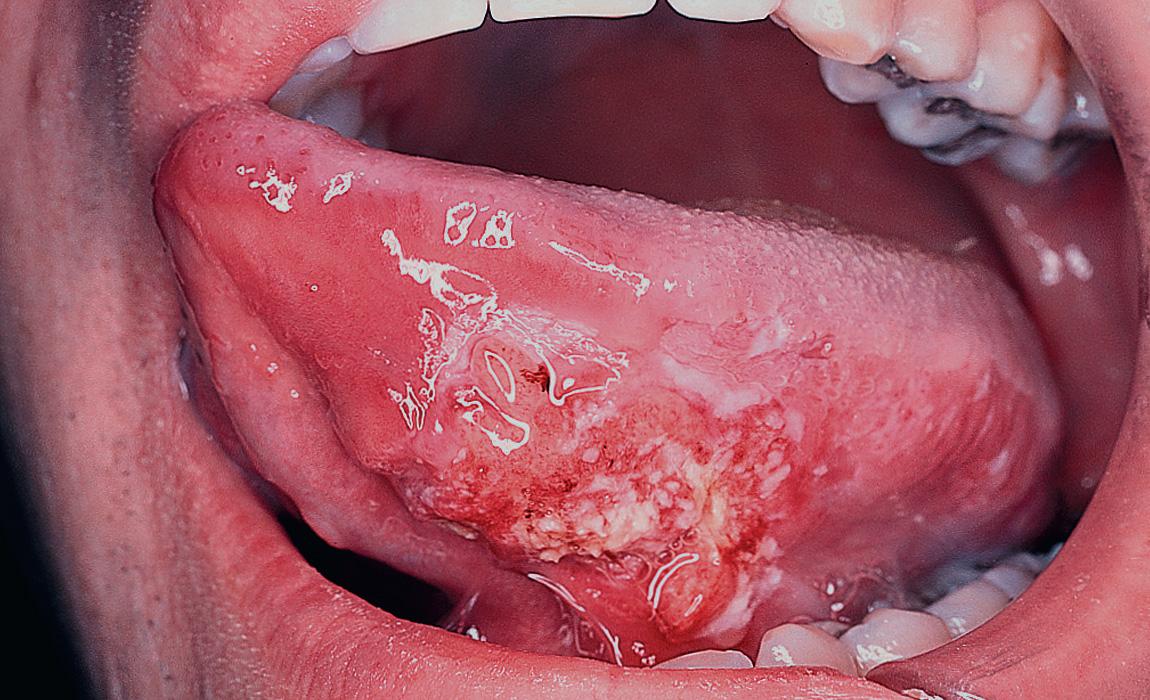

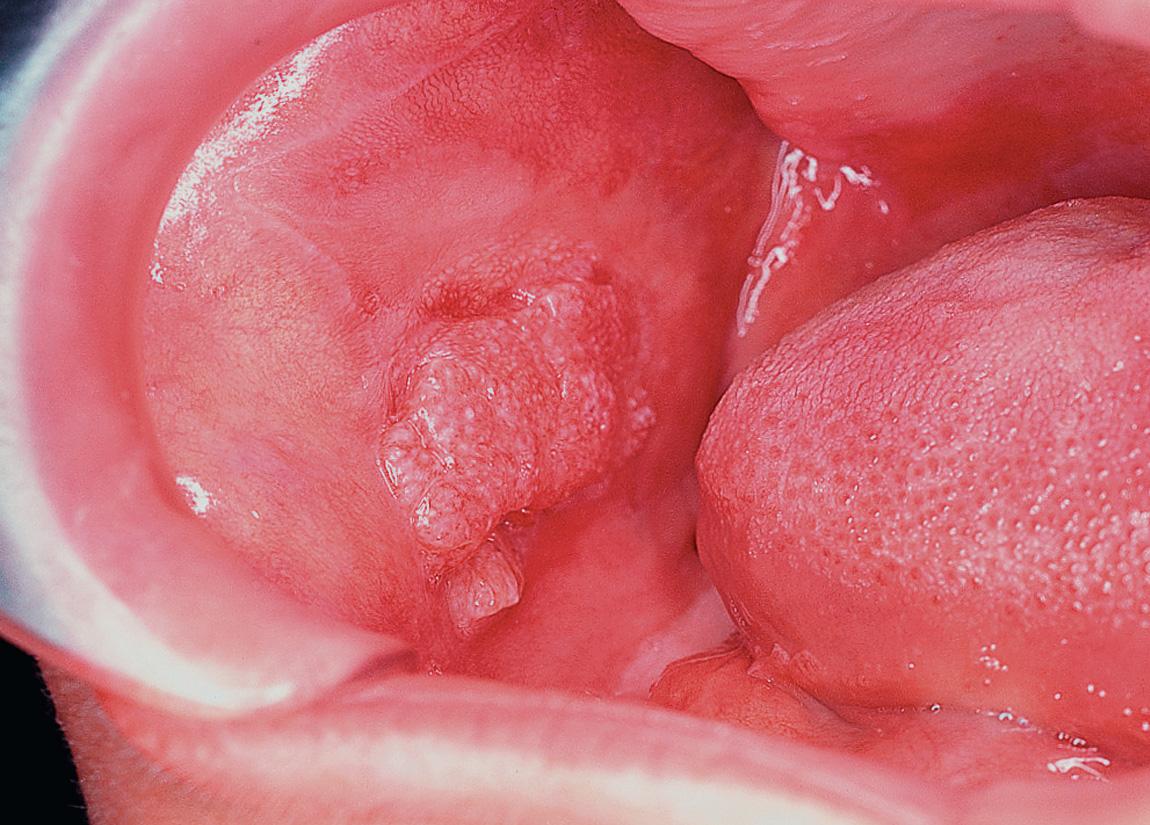
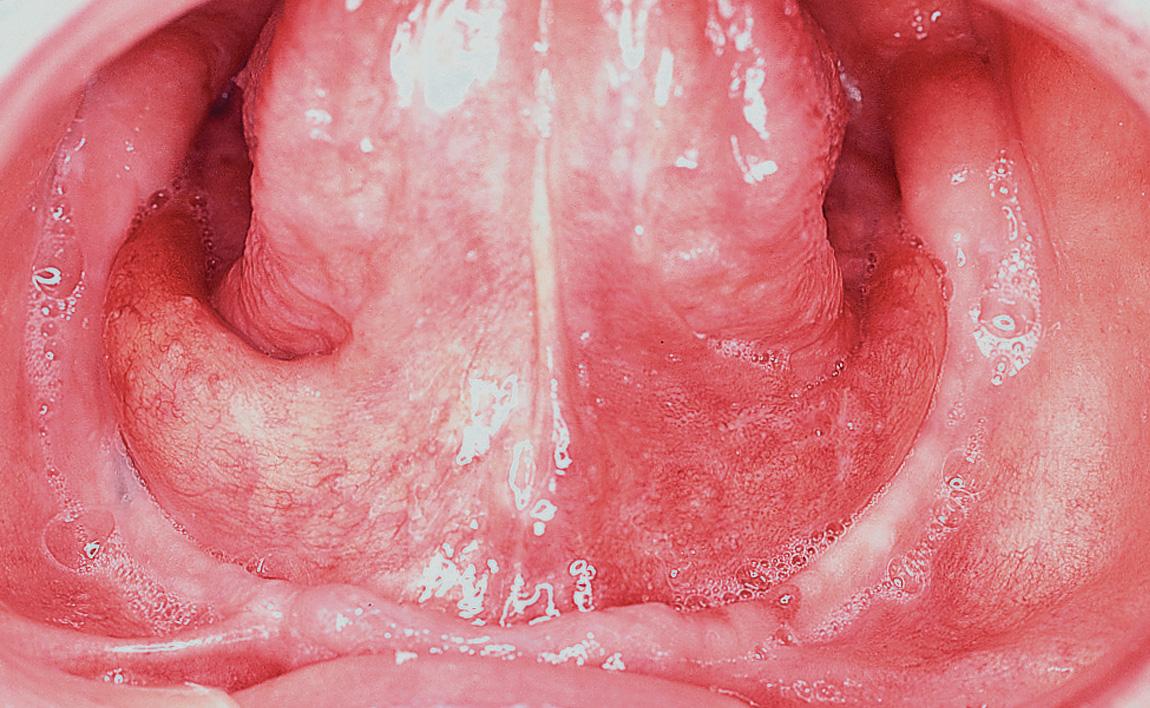
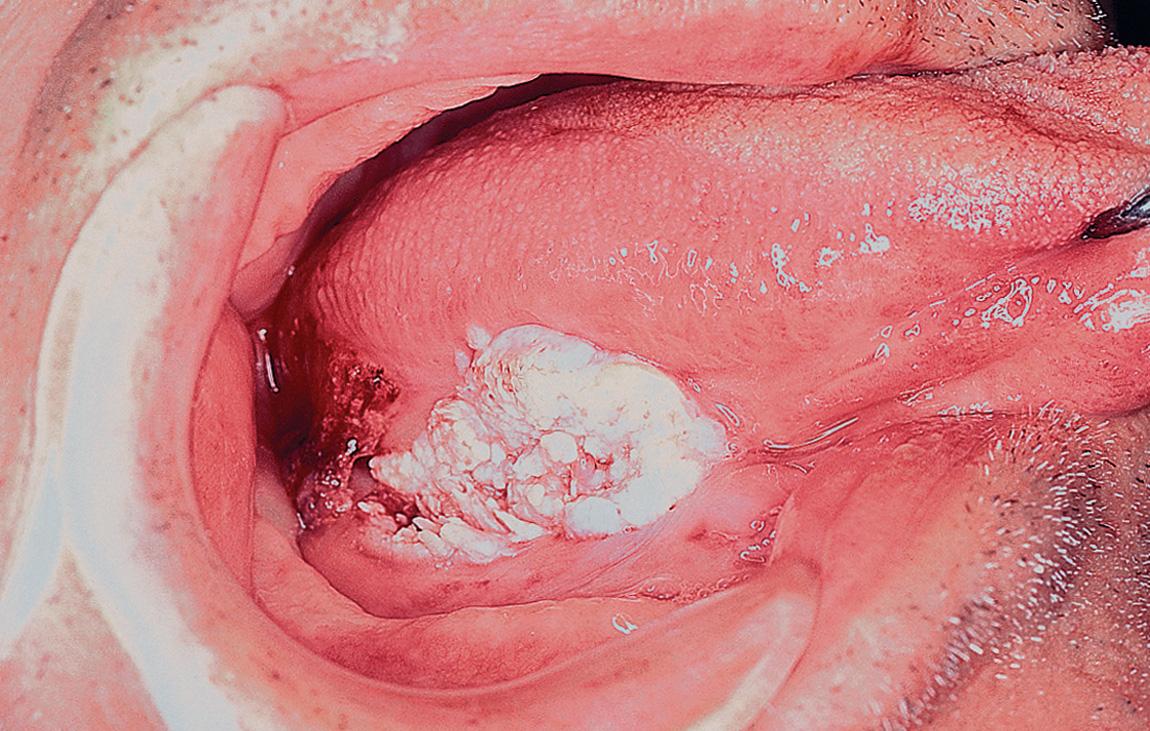

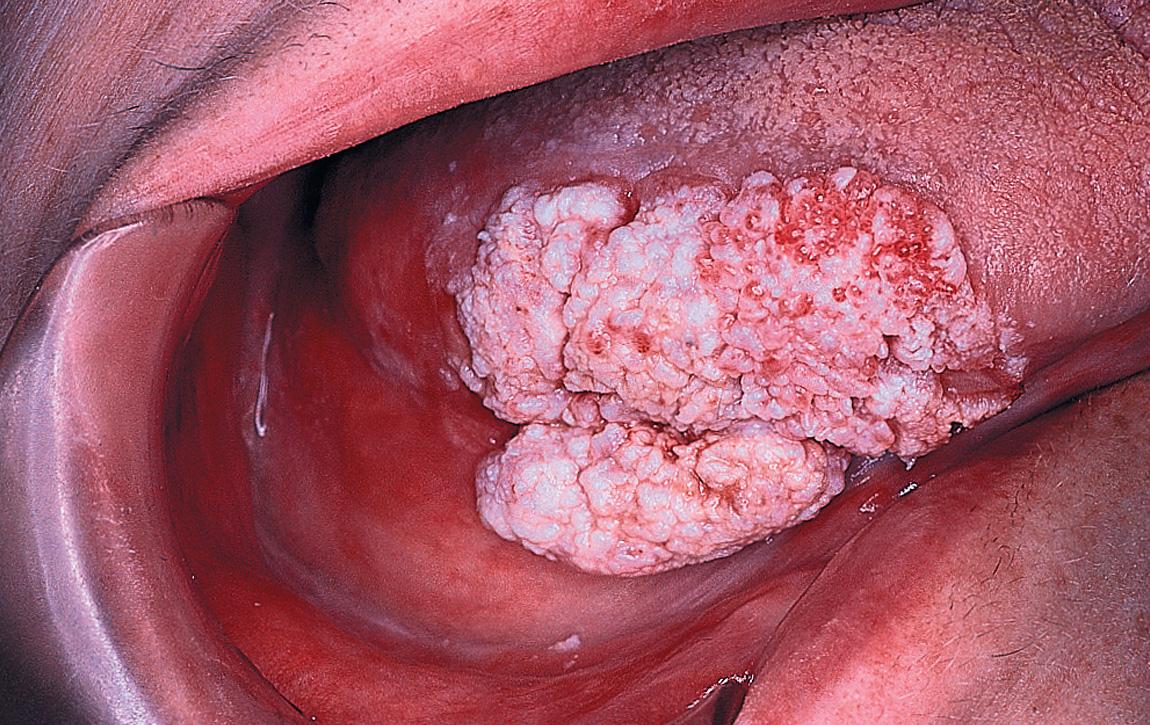
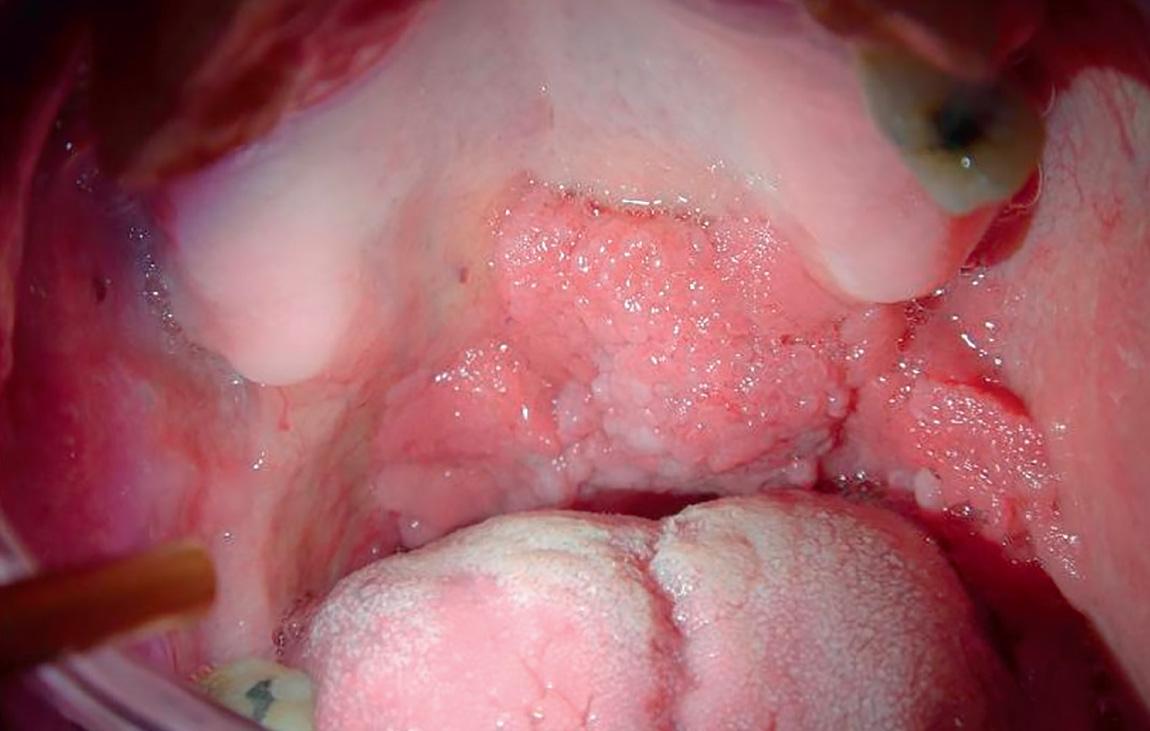

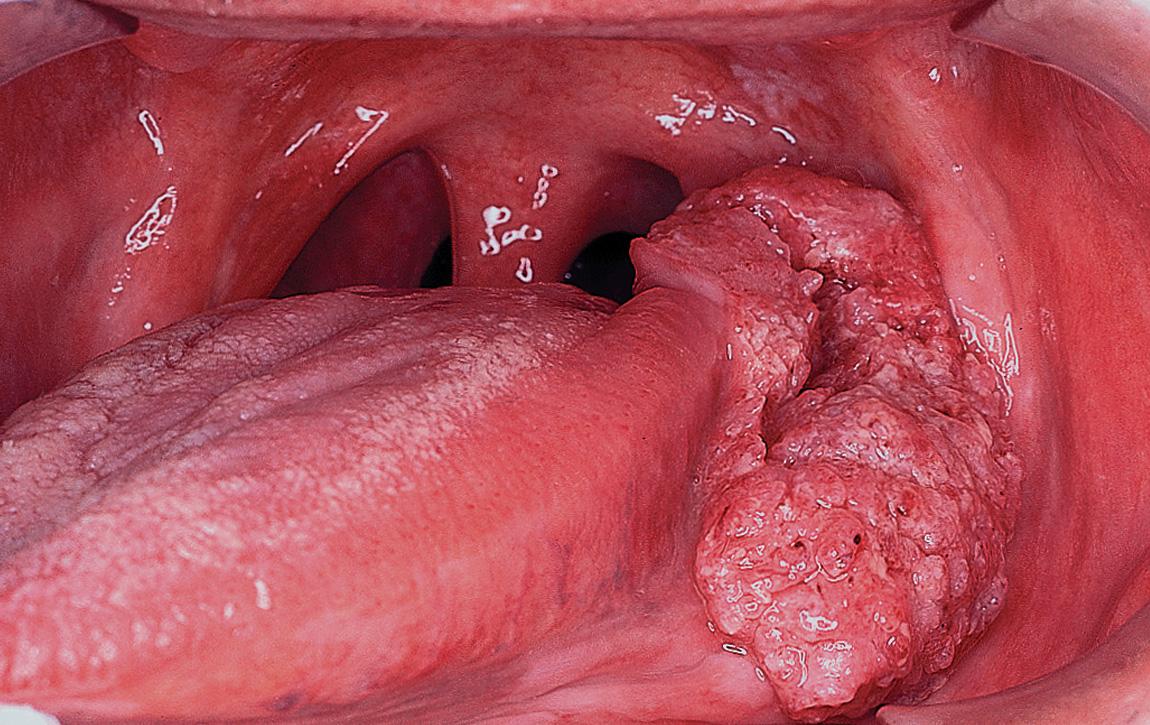
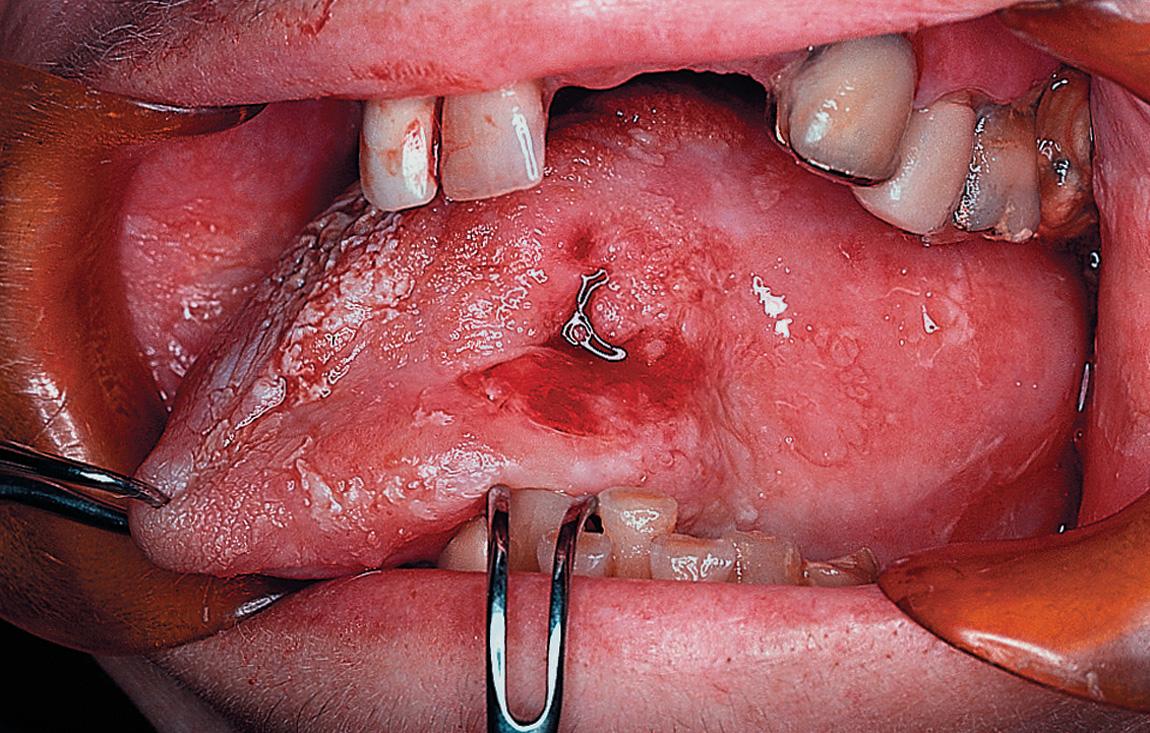
Diagnosis of precancerous lesions or early cancer can be difficult. Leukoplakia and erythroplakia are precancerous lesions that have a varying risk of progression to malignancy. Conversion from leukoplakia to carcinoma is reported in up to 5% to 7% of patients observed over several years. Keratoses of a variety of degrees manifest as leukoplakia ( Figs. 8.16 through 8.20 ). Erythroplakia usually manifests as a pinkish, velvety flat discoloration without any papillary projections ( Fig. 8.21 ). The risk of development of malignancy in erythroplakia approaches 30%. Speckled leukoplakia has a particularly high incidence of malignant transformation, similar to erythroplakia ( Fig. 8.22 ). Synchronous multiple primary cancers occur in approximately 4% of patients with oral cancers ( Figs. 8.23 through 8.25 ). Therefore a thorough examination of the upper aerodigestive tract mucosa should be performed in every case. Mucosal melanomas usually present as characteristic pigmented lesions, although they can be amelanotic ( Figs. 8.26 and 8.27 ). Tumors of minor salivary origin present as submucosal masses ( Figs. 8.28 through 8.31 ). Metastatic tumors also may present as submucosal masses ( Fig. 8.32 ). A variety of benign conditions can have an appearance that resembles malignant neoplasms ( Figs. 8.33 and 8.34 ). A high index of suspicion is crucial to early diagnosis of cancer, especially in high-risk individuals. Biopsy and histopathologic examination represent the standard of care for diagnosis, but noninvasive in vivo imaging techniques such as reflectance confocal microscopy (RCM) are showing promise ( Figs. 8.35 and 8.36 ). The RCM can be performed with a handheld probe in an outpatient setting, without the need for anesthesia.
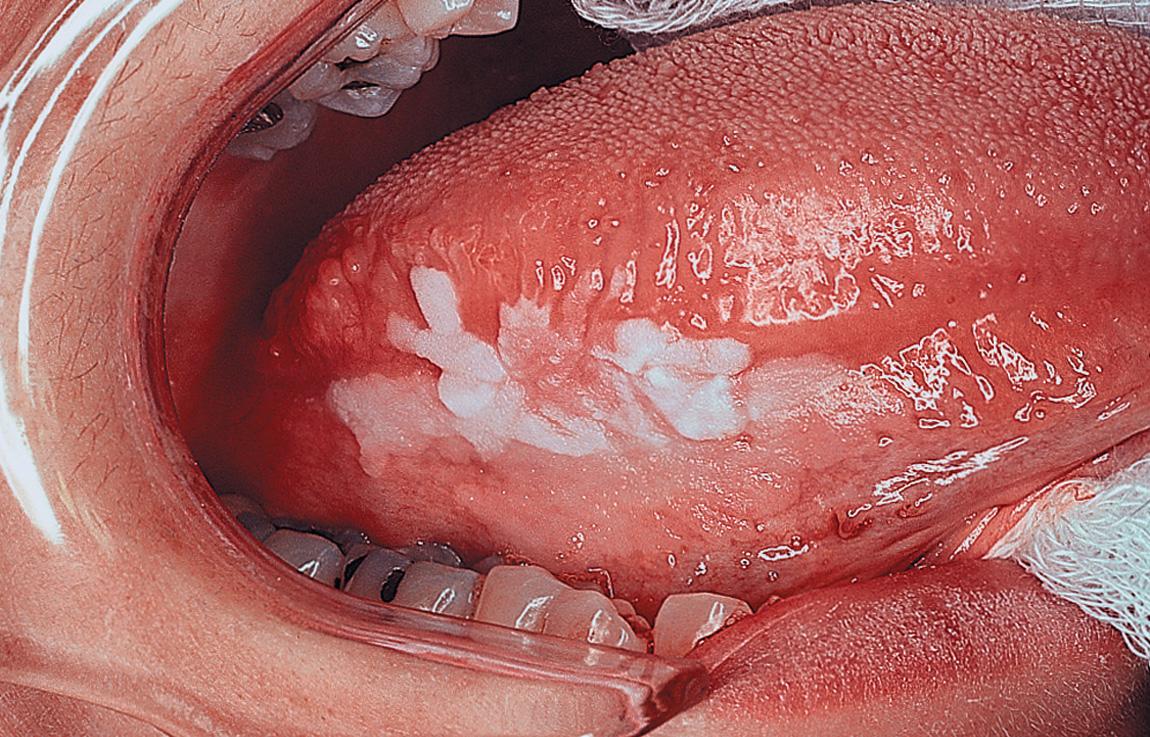
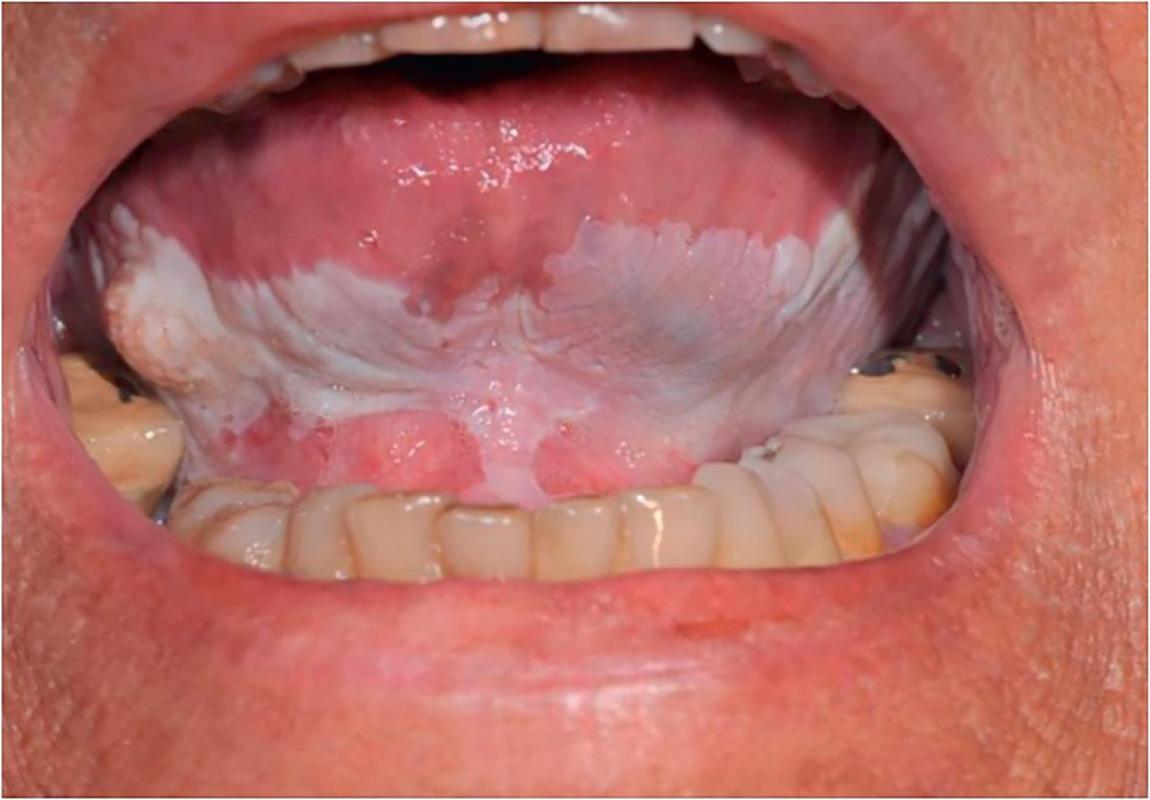

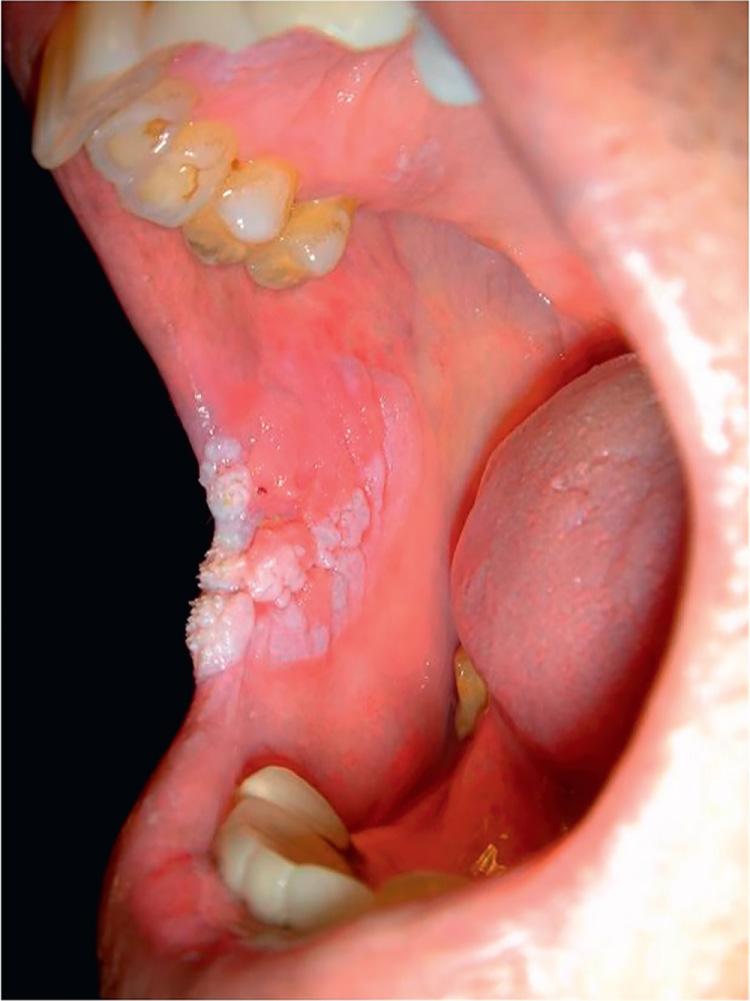
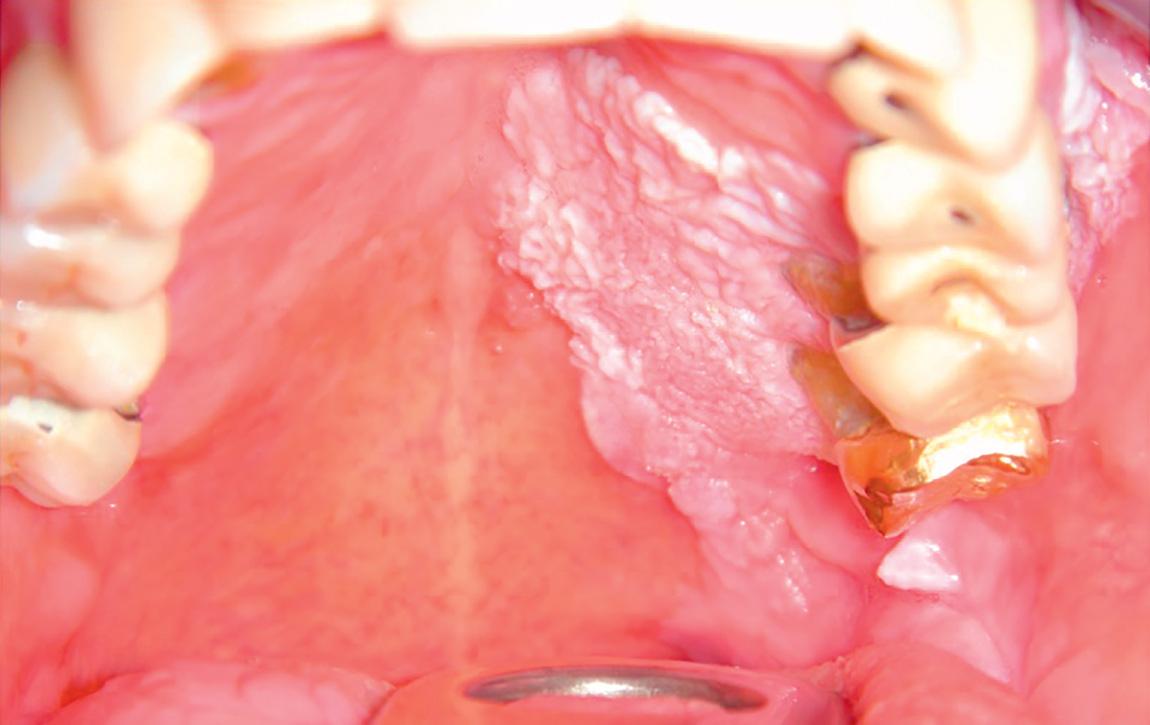
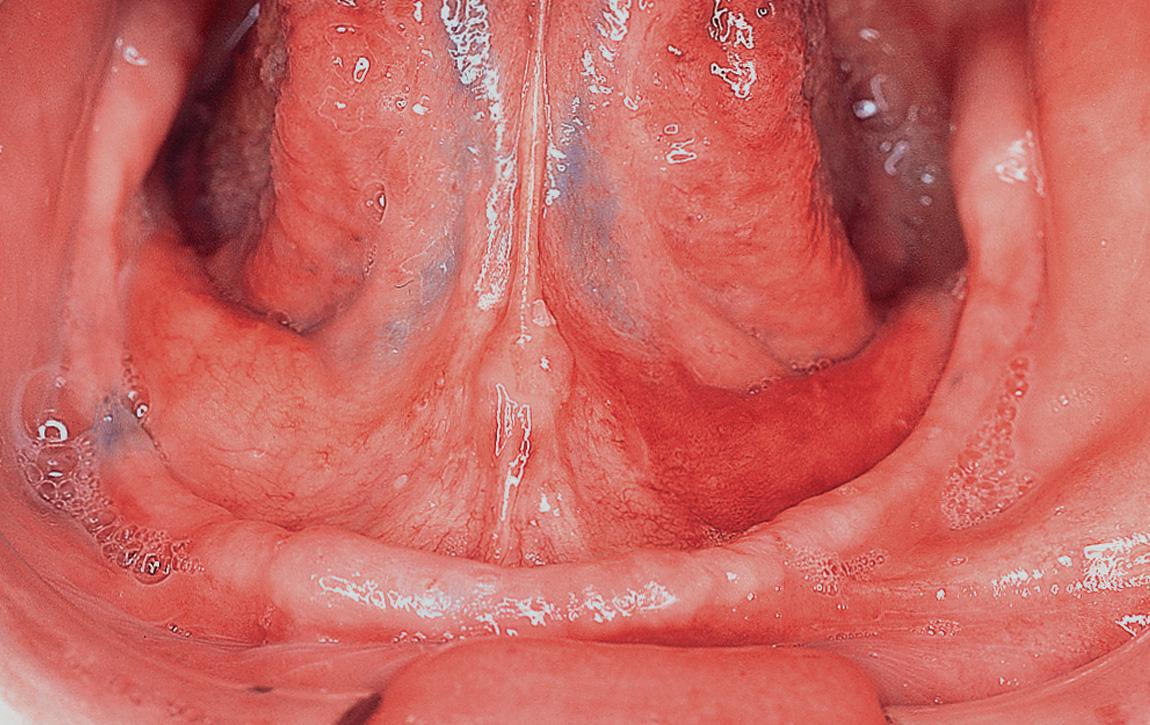
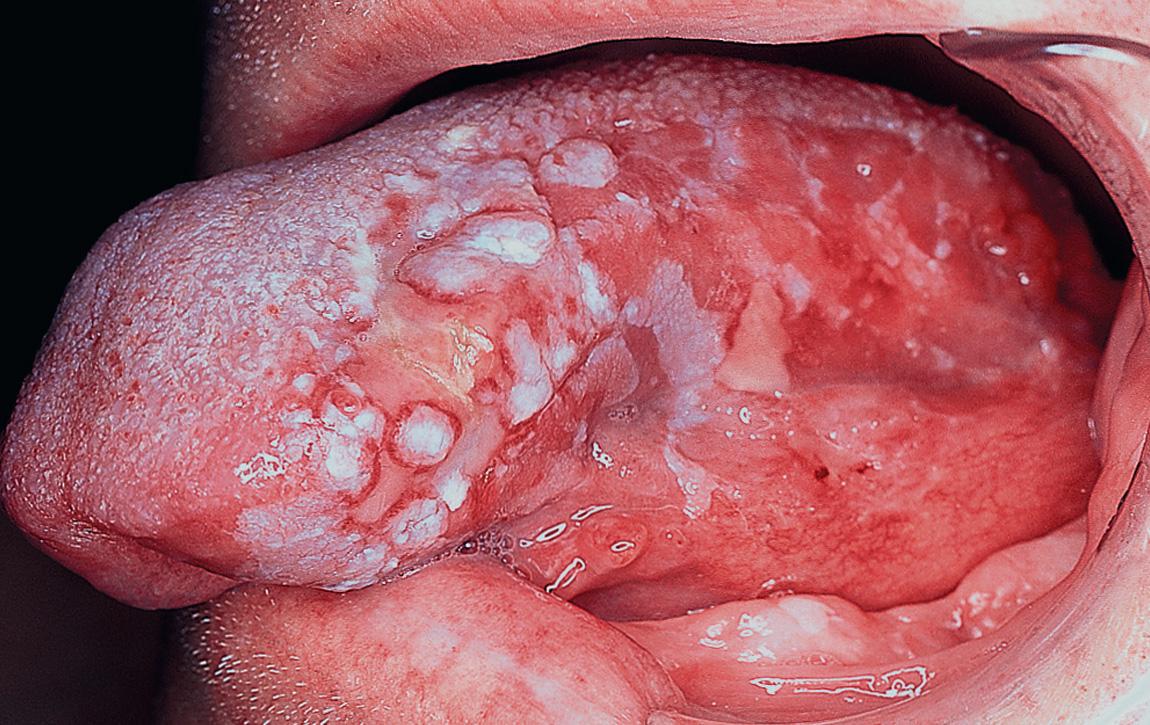
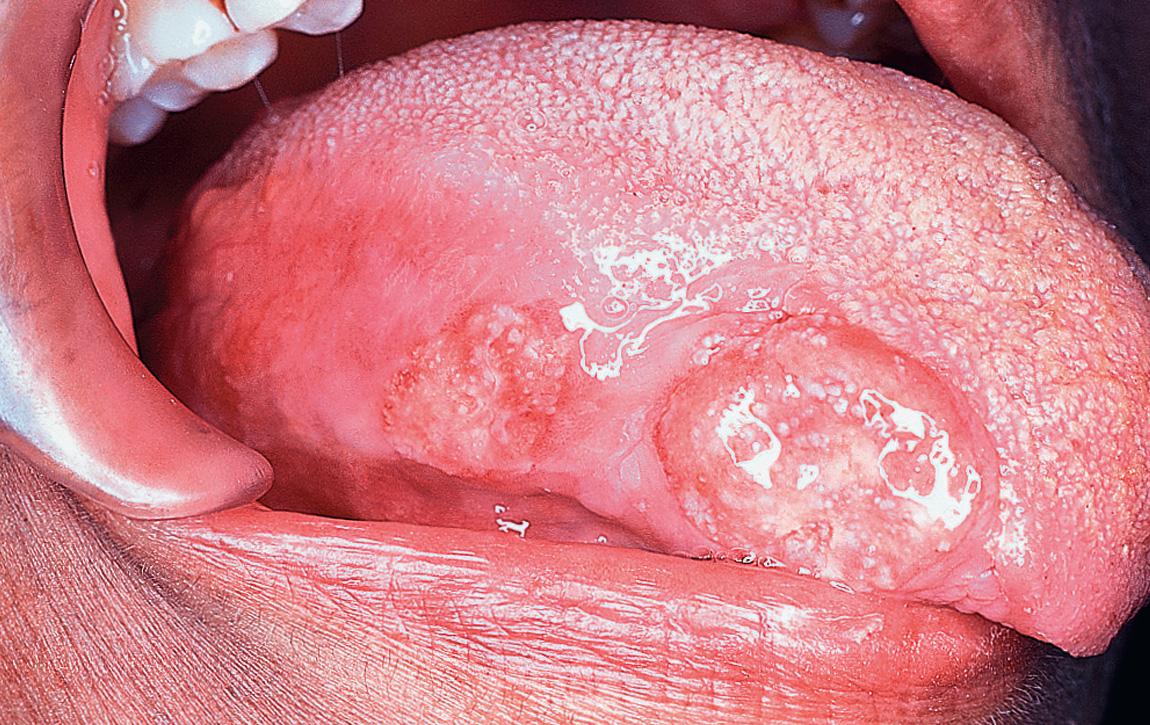


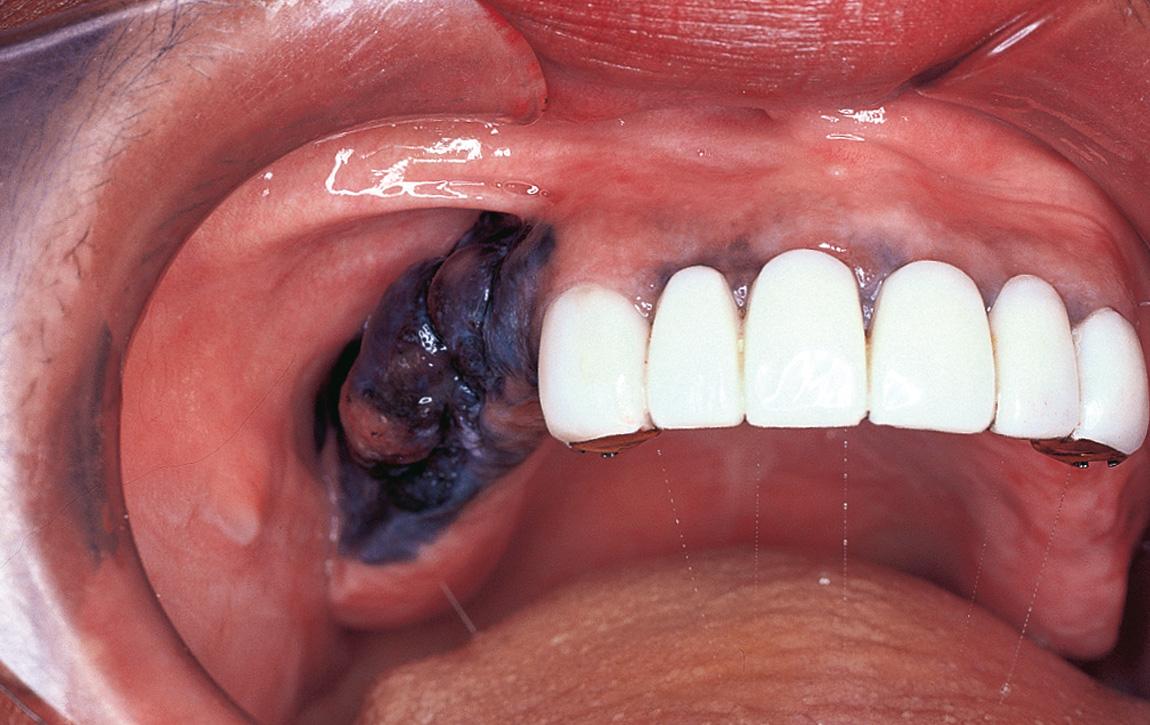
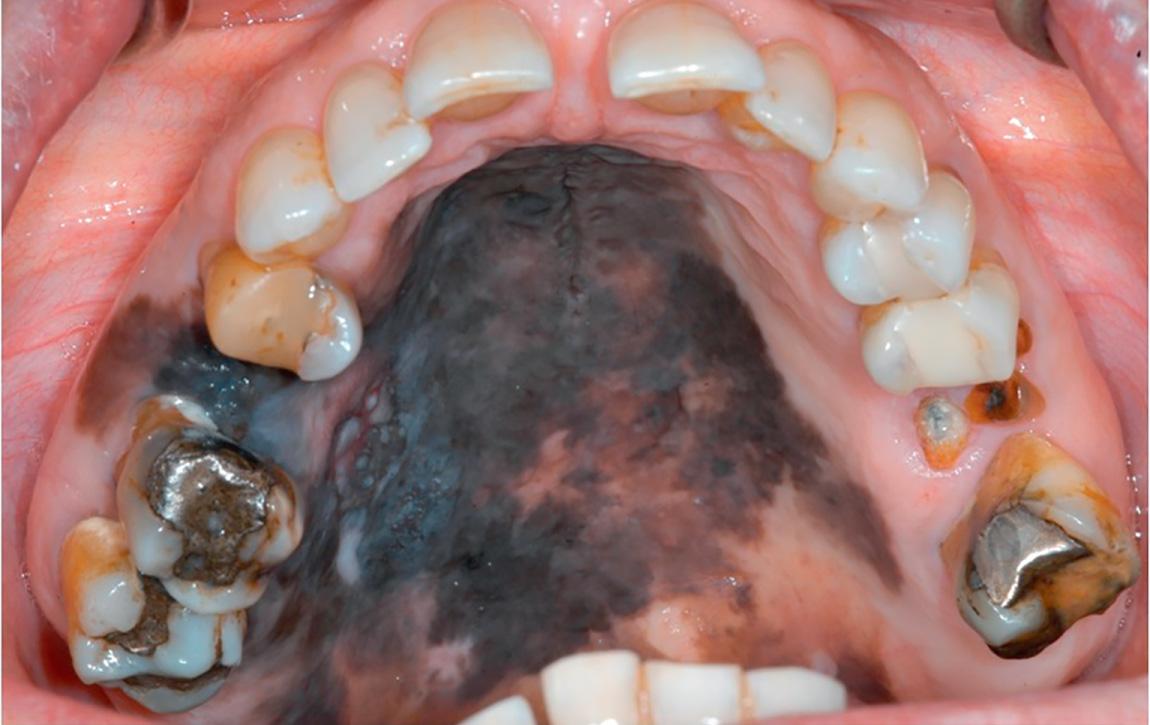

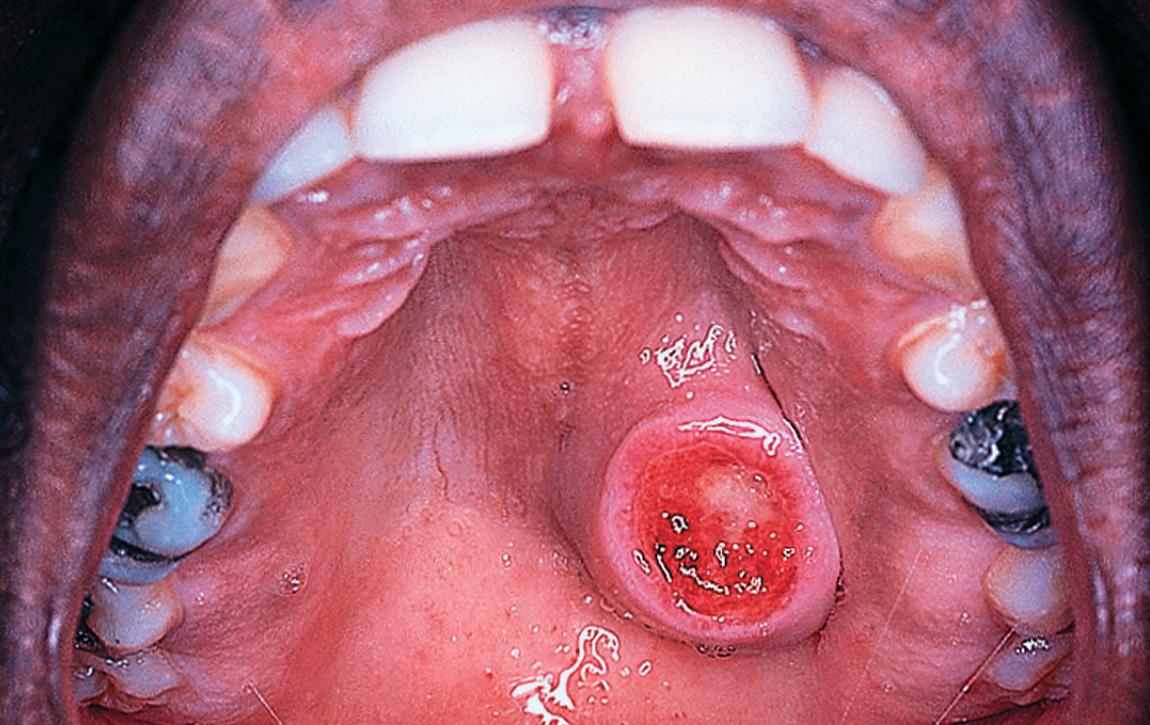







Tissue diagnosis is usually confirmed by a wedge or punch biopsy obtained from the lesion with adequate volume of viable tissue. A biopsy specimen taken from necrotic areas of the tumor is not adequate, and therefore attention must be given to obtaining a vascularized, viable tumor specimen. Superficial biopsy specimens from highly keratinizing squamous cell carcinomas and verrucous carcinomas often do not provide satisfactory representative tissue, and thus the diagnosis of invasive carcinoma can be missed. Therefore in situations in which an excessive deposit of keratin is seen on the surface of an exophytic lesion, the biopsy should be obtained from the adjacent invasive zone or from the depth of the lesion rather than from the surface. If a biopsy does not show carcinoma in a lesion that clinically shows signs of malignancy, then the biopsy should be repeated.
The staging of primary tumors of the oral cavity as published by the AJCC and UICC is widely accepted. In its most recent revision (eighth edition of the AJCC Staging Manual), depth of invasion (DOI) is added to the surface dimensions and local extent of the tumor as the required parameters for primary tumor staging in the oral cavity ( Fig. 8.37 ). Accurate assessment of DOI by clinical examination is not possible. However, the staging system stratifies DOI by 5 mm increments, and thus clinical estimates of DOI can be categorized into thin (<5 mm), thick (5-10 mm), and very thick (>10 mm) by palpation to assign clinical T stage ( Fig. 8.38 ). The stage distribution of patients with squamous cell carcinoma of the oral cavity at the Memorial Sloan Kettering Cancer Center in New York is shown in Fig. 8.39 .

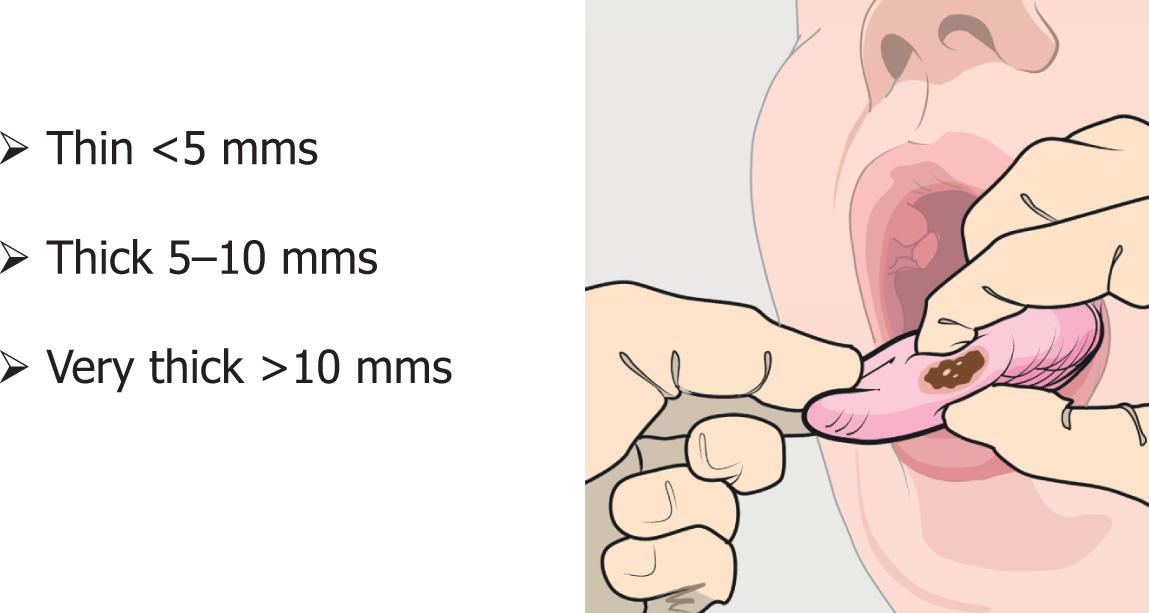
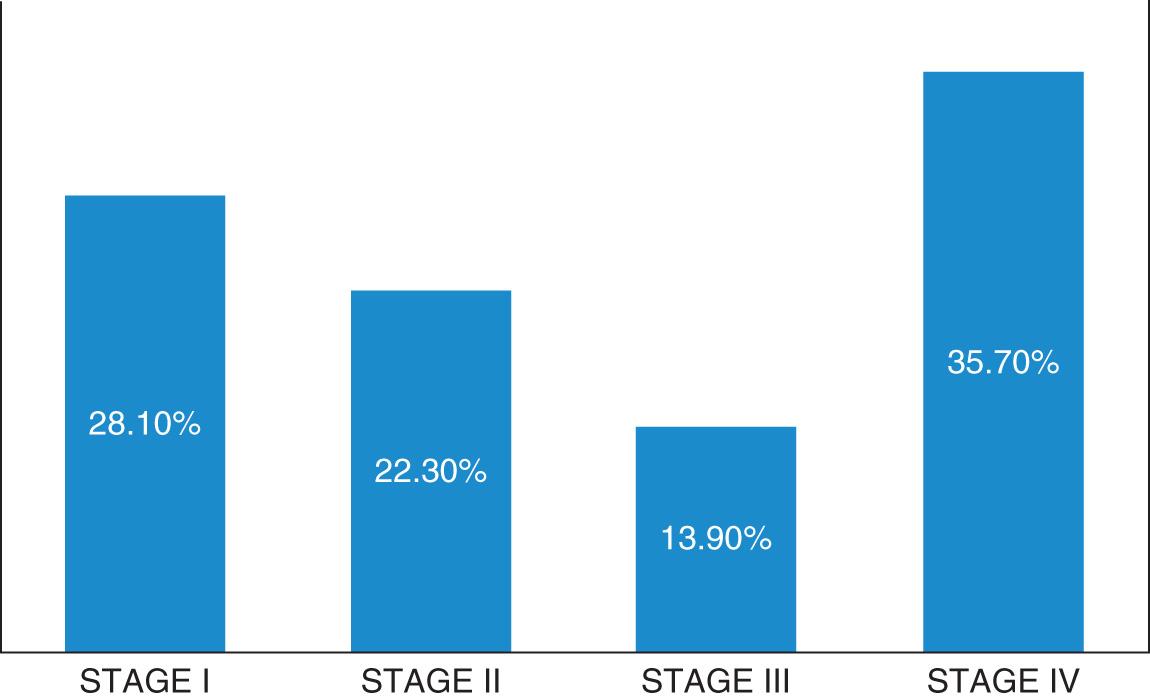
The proximity or direct extension of a primary tumor of the oral cavity to the mandible requires appropriate radiologic studies to establish the presence and extent of bone involvement. Although the absence of radiographic findings does not rule out bone invasion, bone destruction as seen on the radiograph confirms tumor invasion.
Plain radiographs of the mandible in the anteroposterior and oblique views are not satisfactory as a routine screening test to establish or rule out bone destruction. A panoramic view of the mandible (an orthopantomogram) is helpful to assess the general architecture of the mandible in relation to the dentoalveolar structures and invasion by the tumor ( Fig. 8.40 ). However, for technical reasons, the midline of the mandible near the symphysis is not adequately evaluated by a panoramic x-ray. In addition, early invasion of the lingual cortex of the mandible cannot be assessed on a panoramic view. A computerized tomogram of the oral cavity and neck is the standard initial radiographic study for assessment of locoregional extent of the tumor. It allows comprehensive evaluation of neck nodes and also the relationship of the primary tumor to adjoining bone, especially in situations such as primary tumors of the mandible and lesions where soft-tissue extension from tumors involving the ascending ramus of the mandible is suspected ( Fig. 8.41 ).
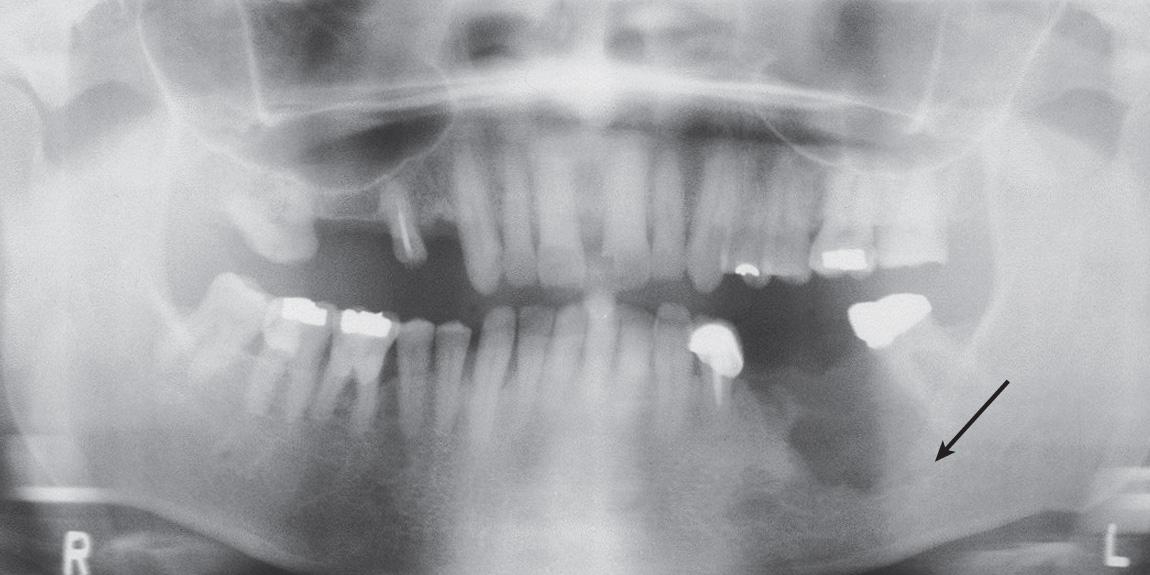
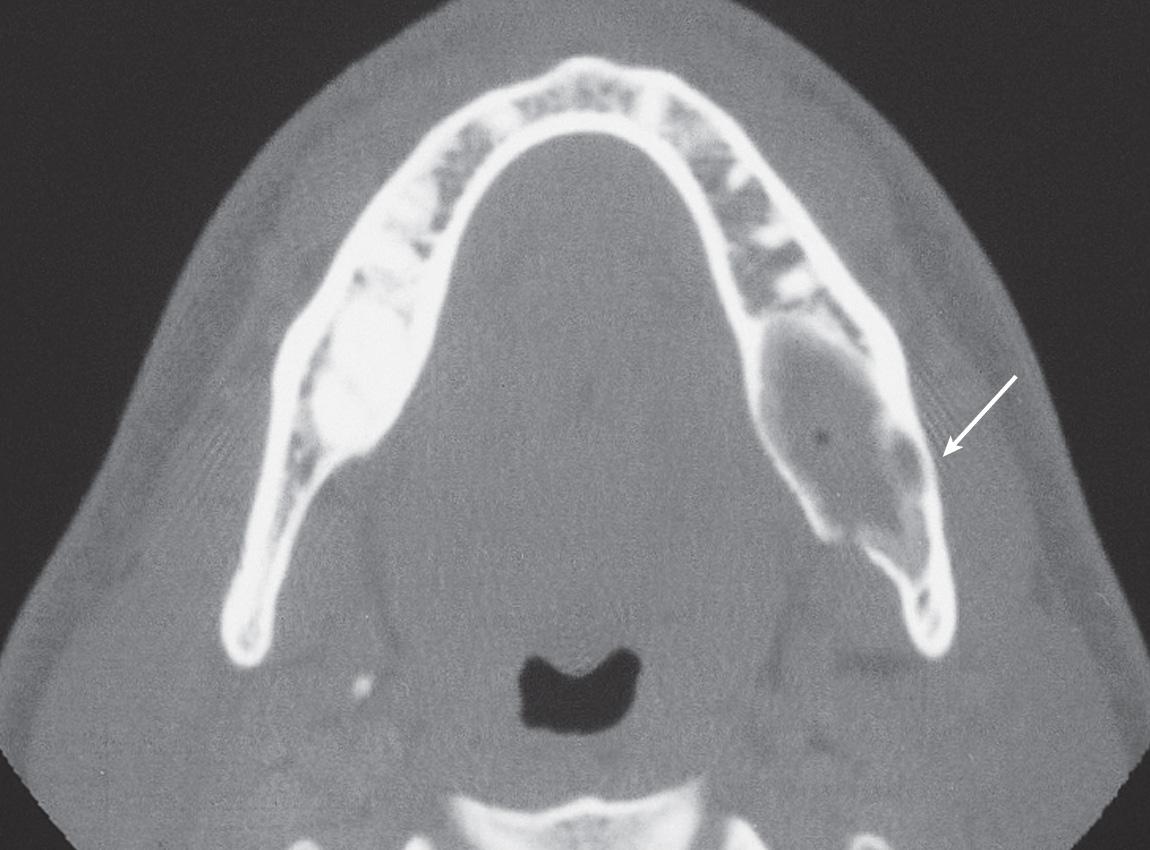
In addition, three-dimensional reconstructions of CT images provide an excellent overview of the mandible or maxilla from any desired angle. Three-dimensional reconstructions of the mandible of a patient with an ossifying fibroma of the body of the mandible on the left-hand side causing expansion and involving the lingual cortex are shown in Figs. 8.42 and 8.43 . A three-dimensional CT scan and computer-assisted design and computer-assisted model (CAD-CAM) planning is of great value to the surgeon for mandible reconstruction with a microvascular free flap. This process is a significant advance in reconstruction of mandibular defects and dental implant planning (see Chapters 17 and 18 ). Invasion of the maxilla by primary tumors of the oral cavity, such as those arising from the palate or upper alveolus, is best assessed by a CT scan. It is important to obtain coronal cuts of the computerized scans with soft tissue and bone windows to adequately assess the extent of tumor involving the hard palate and alveolus.


Magnetic resonance imaging (MRI) is superior in defining soft-tissue detail, evaluating bone marrow invasion of the mandible and hard palate, and assessing for perineural invasion. A sagittal MRI scan of a patient with an endophytic tongue carcinoma vividly demonstrates its intramural extent ( Fig. 8.44 ), as seen in the bisected specimen ( Figs. 8.45 and 8.46 ). Also, in situations in which extensive soft-tissue invasion in the parapharyngeal space is suspected, an MRI scan is desirable. However, bony details are not very well delineated on MRI, and a CT scan is preferred in these situations. Regardless of the presence or absence of invasion of the mandible or maxilla by a tumor, if any bone resection or osteotomy is to be undertaken for surgical treatment of a primary tumor of the oral cavity or oropharynx, appropriate radiographic studies of the bone under consideration must be obtained before the surgical procedure to avoid any “surprises” on the operating table. Early invasion of the mandible is difficult to detect even on a CT scan, but on a practical basis, tumors that are in close proximity to the mandible without demonstrable radiographic bone invasion are adequately treated with a marginal mandibulectomy ( Fig. 8.47 ). When assessing patients who have no obvious bone invasion on a CT scan, it is important to examine the coronal views to image the relationship of the tumor to the craniocaudal height of the mandible. Marginal resection may not be safe even in the absence of bone invasion if the tumor extends along the entire height of the mandible ( Fig. 8.48 ). In the presence of gross invasion of the mandible, CT provides useful information on the extent of bone that needs resection ( Fig. 8.49 ). Extent of bone marrow involvement is best evaluated on T1-weighted MRI, which nicely demonstrates replacement of adult fatty marrow ( Fig. 8.50 ).
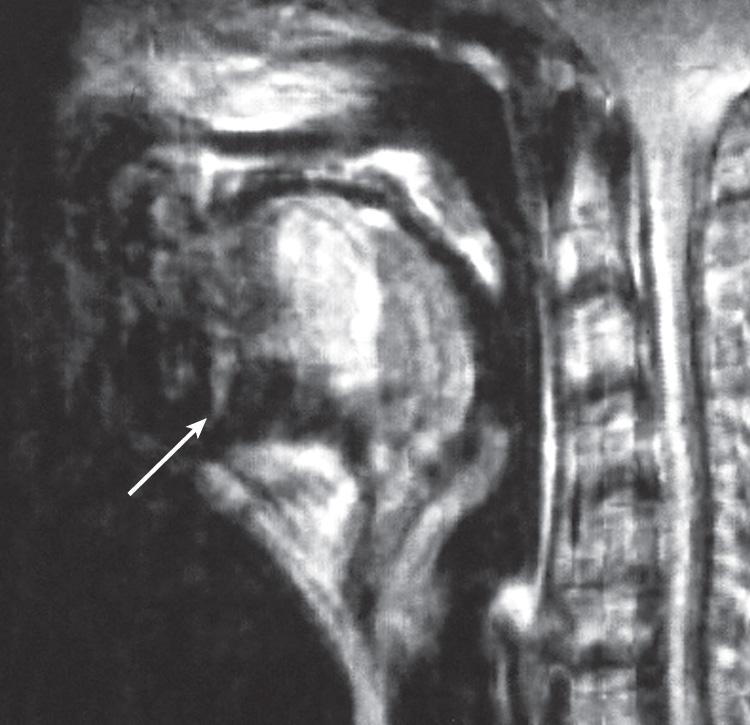



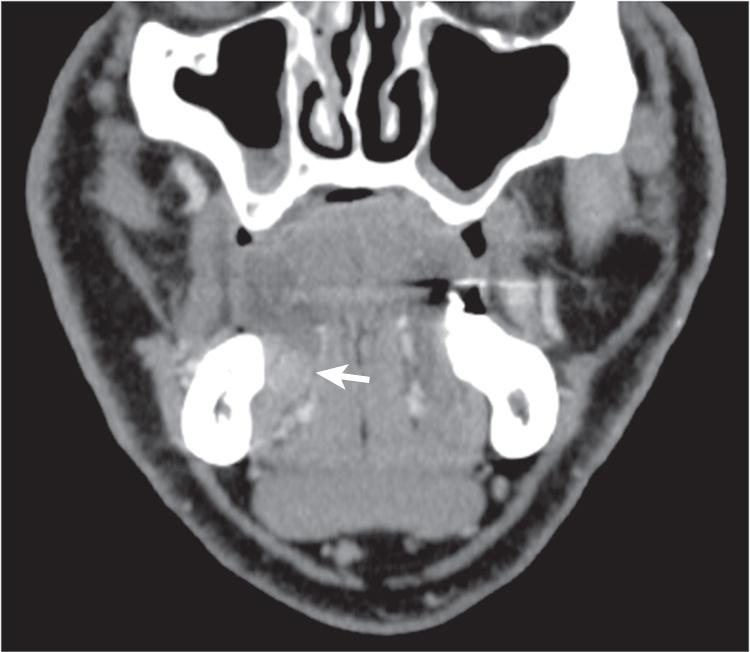


Most lesions of squamous cell origin have a varying degree of histologic progression from in situ to invasive carcinoma. The histologic grade of the lesion generally reflects the aggressiveness of the tumor. Squamous cell carcinoma may range from well differentiated to poorly differentiated as well as undifferentiated and sarcomatoid, as defined by the extent to which a tumor demonstrates nuclear pleomorphism, cytologic atypia, and morphologic resemblance to benign squamous mucosa. The histologic grade reflects the aggressiveness of the tumor. Tumors that are undifferentiated or sarcomatoid are the most aggressive.
The most important histologic feature of the primary tumor that affects selection of treatment and eventual prognosis is its DOI. Thin and superficially invasive lesions have a lower risk of regional lymph node metastasis, are highly curable, and offer an excellent prognosis. On the other hand, thicker lesions that deeply infiltrate the underlying soft tissues have a significantly increased incidence of regional lymph node metastasis and an adverse impact on prognosis. The risk of lymph node metastasis and survival rates in relation to the DOI of the primary lesion for T1 and T2 squamous carcinomas of the oral tongue and floor of mouth are shown in Fig. 8.51 . Although it would be ideal to know the exact DOI of the lesion before surgical intervention, having that information before surgical excision and histopathologic examination of the primary tumor is not possible. In general, however, estimate of DOI by assessing thickness of the lesion as appreciated by palpation is a reasonably good indicator of deeply invasive lesions versus superficial lesions to estimate the extent of soft tissue and/or bone resection for the primary lesion and to decide on the need for elective dissection of the regional lymph nodes at risk in a clinically negative neck. Several retrospective studies have identified DOI of the primary tumor as an important determinant of prognosis. Thus DOI is now included in T staging of primary tumors of the oral cavity. The presence of perineural invasion and the presence of lymphovascular tumor emboli are other prognostic indicators for tumor control and survival. Local control of the primary tumor is also affected by the pattern of tumor infiltration, with single cell infiltration more unfavorable than a broad, “pushing” border. As one would expect, negative margins are another key factor in locoregional control. In reporting pathologic analysis of resected oral cancer specimen, tumor clearance from the closest margin should be reported. Traditionally, the presence of invasive carcinoma within 5 mm is felt to be associated with a significant risk of local recurrence. However, some studies report that the risk of recurrence in oral tongue squamous cell carcinoma starts to increase when the tumor is within 2 mm rather than 5 mm from the margin. Histologic features of the primary tumor that have an impact on therapeutic outcomes are shown in Box 8.1 .

Degree of differentiation
Size of tumor
Depth of invasion
Endophytic versus exophytic growth
Lymphovascular invasion
Perineural invasion
Invasive front
Margins
Bone invasion
The goals of treatment of cancer of the oral cavity are (1) cure of the cancer; (2) preservation or restoration of speech, mastication, swallowing, and external appearance; (3) minimization of the sequelae of treatment such as dental decay, osteonecrosis of the mandible, and trismus; and (4) selecting options with the awareness of the risk of subsequent primary tumors and their management. Factors that influence the choice of initial treatment are related to the characteristics of the primary tumor (tumor factors), the patient (patient factors), and the treatment team (physician factors).
In general, small and superficial tumors of the oral cavity are equally amenable to being cured by surgical resection or radiotherapy. Therefore use of a single modality is preferred as the definitive treatment in early stage (T1 and T2) tumors of the oral cavity. When the end point of treatment, that is, cure of cancer, is comparable, other factors must play a role in the selection of initial treatment. These factors include complications, cost, convenience, compliance, and long-term sequelae of treatment ( Fig. 8.52 ). Considering these factors, surgery is the preferred treatment for T1 and T2 tumors of the oral cavity.
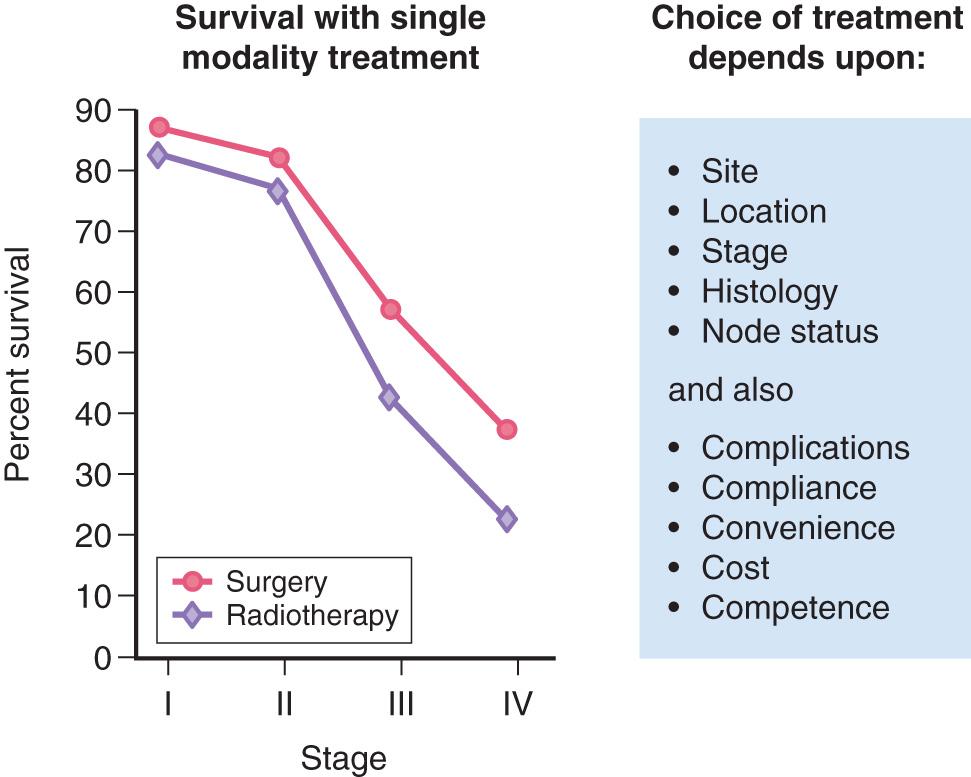
Single modality treatment with either surgery or radiotherapy in advanced stage (T3 and T4) oral cancer offers poor locoregional control and survival. Combining adjuvant postoperative radiotherapy offers improved locoregional control but has not improved survival. Two independent, prospective, randomized trials of adding concurrent chemotherapy to postoperative radiotherapy (Radiation Therapy Oncology Group [#22931] and European Organization for Research and Treatment of Cancer [#9501]) in patients with advanced stage (III and IV) squamous cell carcinomas of the head and neck with high-risk features show improved locoregional control and survival compared with postoperative radiation alone. Further analysis of the data from these trials suggests that the most important high-risk features are positive margins and extranodal spread of metastatic cancer. Relative high-risk factors include multiple positive nodes, perineural or vascular invasion, and metastasis to lymph nodes at level 4 or 5. Adding chemotherapy to postoperative radiation has helped to improve local control compared with radiation alone, but the acute high-grade toxicity and significant long-term morbidity associated with postoperative chemoradiotherapy remain significant problems. More importantly, only about a quarter of patients in these two trials had primary oral cancer, of which only a small percentage received adjuvant treatment solely for positive margin status. Further research in defining the optimal treatment for advanced stage oral cancer is essential.
Although studies suggest that brachytherapy results in good disease control rates for cancers of the tongue, it usually requires placement of a tracheostomy and can result in worse functional outcomes compared with primary surgical treatment.
Oral cavity cancers typically do not respond well to radiotherapy; therefore surgery is the preferred treatment modality. In select cases, tumors of the tongue, the floor of the mouth, and the buccal mucosa classified as T1 and select cases of early T2 tumors can be treated with radiation alone—either external beam radiotherapy, brachytherapy, or both. If a combination of external beam radiotherapy and an interstitial implant is considered for oral tongue lesions, use of an adequate interstitial implant dose is important, because according to several reports, the dose is correlated with local control.
Management of cancer of the oral cavity is a multidisciplinary team effort, and technical capabilities and support services from various disciplines are essential for a successful outcome. A comprehensive head and neck surgery team includes not only the head and neck surgeon but also other surgical specialties, including plastic and reconstructive surgeons with expertise in microsurgery, dental and maxillofacial prosthodontists, and rehabilitation specialists.
Factors that influence the choice of surgical treatment for a primary tumor of the oral cavity are tumor factors such as the size and site of the primary tumor (i.e., anterior versus posterior location), its depth of invasion, and the proximity of the tumor to the mandible or maxilla. Therefore thorough clinical assessment of the primary tumor is mandatory to ensure that the appropriate surgical procedure is selected. Examination under anesthesia often is indicated to accomplish this goal. The proximity of the tumor to the maxilla or mandible mandates the need for adequate clinical and radiographic assessment to rule out the possibility of bone involvement. In addition, radiographic evaluation provides information regarding the extent of soft-tissue involvement and the status of the dentition.
The histologic characteristics of the primary tumor (i.e., type, grade, and depth of invasion) and the status of cervical lymph nodes are other important features that influence the surgical approach.
The natural history of primary tumors at different sites in the oral cavity is variable. Primary cancer of the vermilion border of the lip has a biologic behavior similar to that of skin cancer, with an excellent potential for cure and thus a very favorable prognosis. Squamous cell carcinomas of the hard palate and upper gum have an intermediate risk of regional lymph node metastases. On the other hand, cancers of the tongue, floor of the mouth, and lower gum have a higher risk of regional lymph node metastases with an adverse impact on prognosis.
The size of the primary tumor clearly has a heavy significant impact on the decision regarding choice of initial treatment. Small and superficial primary tumors of the oral cavity are easily accessible for surgical resection through the open mouth. On the other hand, larger and/or posteriorly located tumors require more extensive surgical approaches for exposure and excision. With increasing size and depth of invasion of the primary lesion, the risk of regional lymph node metastasis increases, bringing into consideration the need for elective treatment of the neck. In general, primary tumors located in the posterior part of the oral cavity have a higher risk for dissemination to regional lymph nodes compared with similarly staged lesions in the anterior oral cavity. Thus, more posteriorly located lesions require consideration of elective treatment of the clinically negative neck.
Adequate assessment of the mandible for invasion by a tumor is essential for appropriate surgical treatment planning. The mandible is considered at risk when the primary tumor is adherent to or adjacent to the mandible. In addition to careful examination under anesthesia by bimanual palpation, radiographic evaluation of the mandible is essential for surgical treatment planning. To determine the need for and extent of mandible resection, it is essential to understand the pathway by which oral cancers invade the mandible. Primary carcinomas of the mucosal lip, buccal mucosa, tongue, and floor of the mouth extend along the surface mucosa and the submucosal soft tissues to approach the attached labial, buccal, or lingual gingiva. From this point, the tumor does not extend directly through intact periosteum and cortical bone toward the cancellous part of the mandible because the periosteum acts as a significant protective barrier. Instead, the tumor advances from the attached gingiva toward the alveolus. In patients with teeth, the tumor extends through the dental socket into the cancellous part of the bone and invades the mandible via that route ( Fig. 8.53 ). In edentulous patients, the tumor extends up to the alveolar process and then infiltrates the dental pores in the alveolar ridge and extends to the cancellous part of the mandible ( Fig. 8.54 ). Thus in patients with tumors approaching the mandible without infiltration of the tooth sockets, a marginal mandibulectomy is feasible. In edentulous patients, however, the feasibility of marginal mandibulectomy depends on the vertical height of the body of the mandible. With aging, the alveolar process recedes and the mandibular canal comes closer to the surface of the alveolar process. As shown in Fig. 8.55 , resorption of the alveolar process eventually leads to a “pipestem” mandible in elderly patients ( Fig. 8.56 ). It is almost impossible to perform a marginal mandibulectomy in such patients because the probability of iatrogenic fracture or postsurgical spontaneous fracture of the remaining portion of the mandible is very high. Similarly, in patients who have received previous radiotherapy, a marginal mandibulectomy should be performed with extreme caution. The probability of pathologic fracture at the site of the marginal mandibulectomy in such patients is very high.
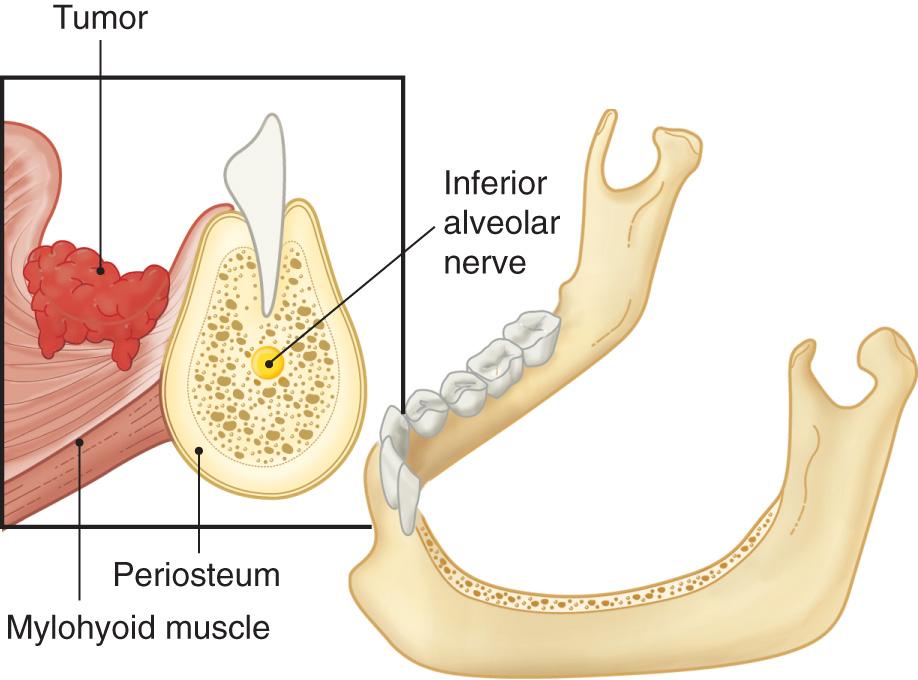
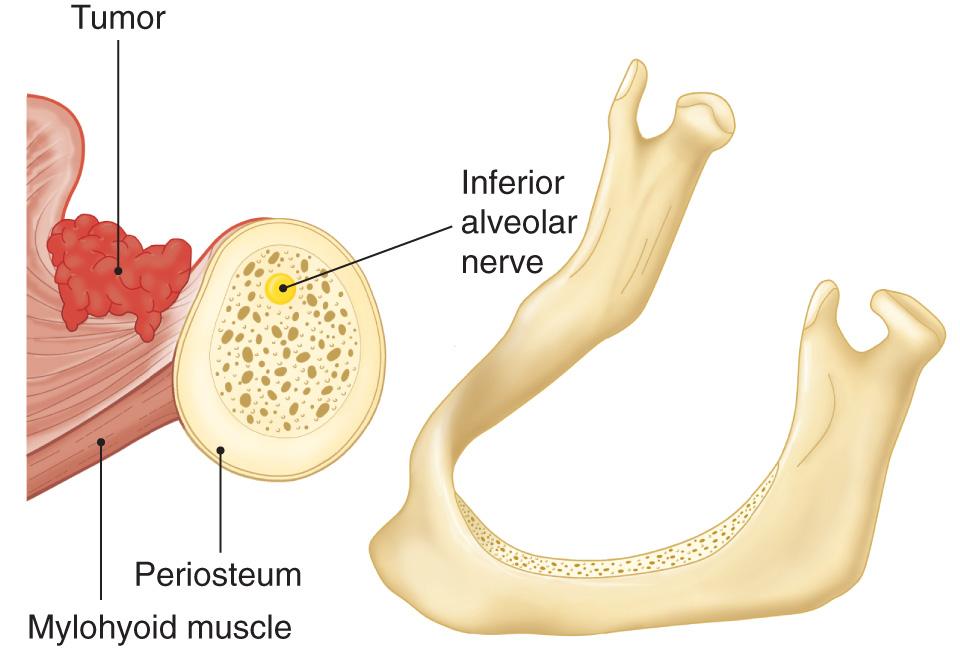
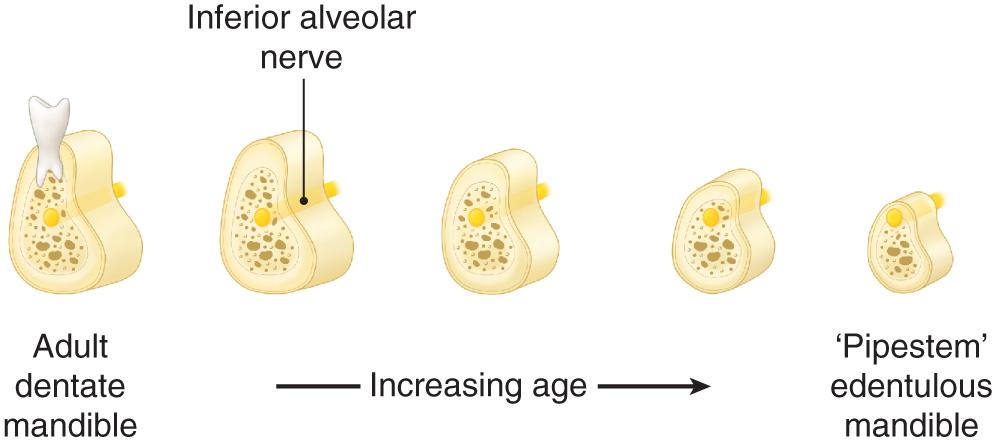
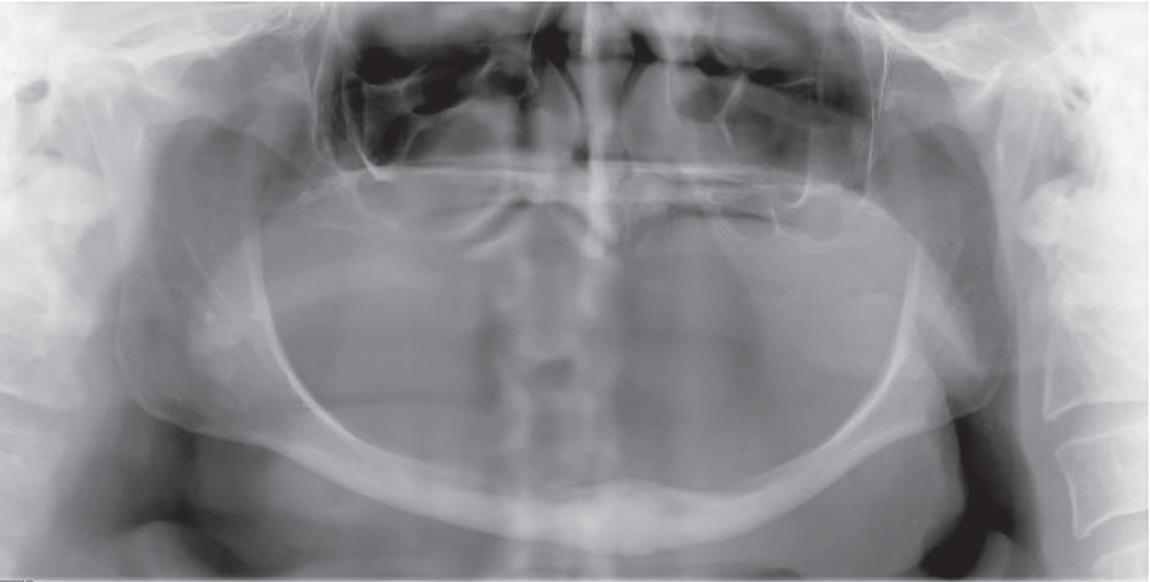
Another important issue about marginal mandibulectomy is the ultimate goal for dental rehabilitation. Implant-based dental rehabilitation is not possible in the molar region of the mandible, due to lack of sufficient bone height above the mandibular canal after marginal mandibulectomy. Therefore, if optimal dental rehabilitation is the goal, then marginal mandibulectomy should not be done in the body of the mandible posterior to the mental foramen. For those patients, segmental mandibulectomy and fibula free flap reconstruction with immediate placement of dental implants would be indicated.
When the tumor extends to involve the cancellous part of the mandible, a segmental mandibulectomy must be performed. A segmental mandibulectomy also may be required in patients with massive primary tumors with significant soft-tissue disease in the proximity of the mandible. Sacrifice of the normal mandible to gain access to the primary tumors of the oral cavity or to accomplish an in-continuity composite resection should be avoided. The concept of the “commando operation” has been revised because no lymphatic channels pass through the mandible, and thus the need for an in-continuity “composite resection” of the uninvolved mandible is not warranted. The current indications for a segmental mandibulectomy include (1) gross invasion by oral cancer; (2) invasion of inferior alveolar nerve or canal by the tumor; (3) massive soft-tissue disease adjacent to the mandible; (4) a primary malignant tumor of the mandible; and (5) a tumor that has metastasized to the mandible.
As with other sites in the head and neck, patient factors such as age, general medical condition, tolerance of surgical treatment, occupation, acceptance, compliance, lifestyle (smoking/drinking), and socioeconomic status are important in the selection of the initial treatment of oral cancer. In addition, specific patient factors that need to be considered in the selection of treatment of oral cancer include status of dentition, the presence of submucous fibrosis or trismus, and continued use of chewing tobacco products. In general, older age is not considered to be a contraindication for implementation of adequate initial surgical treatment for oral carcinoma. However, advancing age, intercurrent disease, and debility due to associated cardiopulmonary conditions increases the risk of morbidity and mortality after extensive surgery. Previous treatment for other lesions in the same area also influences decisions regarding the selection of treatment; for example, radiation therapy previously delivered to the same area for a different lesion may not be available to treat a second tumor in the same area.
Many patients with primary carcinomas of the oral cavity have poor oral hygiene and poor dentition, often harboring gross infection. It is very important that a preoperative dental evaluation and appropriate dental care is provided to achieve optimal hygiene in the oral cavity before a surgical procedure is performed. All grossly septic teeth should be adequately assessed for consideration of extraction, either preoperatively or intraoperatively if indicated. However, teeth (whether loose or immobile within the tumor or in its vicinity) should not be extracted before the definitive surgical procedure. Extraction of teeth near a tumor opens up dental sockets, which increases the risk of implantation of tumor into the mandibular canal. The feasibility of a marginal mandibulectomy is seriously compromised under these circumstances. Deposits of tartar must be removed and appropriate scaling of the dentition must be undertaken to avoid dental complications and prevent sepsis in the oral cavity after surgery. However, any restorative dental work should be postponed until adequate surgical treatment of the primary oral cancer is completed.
If the contemplated surgical procedure requires resection of any part of the mandible or maxilla, appropriate dental consultation should be obtained for consideration of intraoperative placement of dental implants in the reconstructed mandible with a fibula free flap, or for fabrication of either a palatal obturator, mandibular splint, or intermaxillary fixation. If any postoperative splints, obturators, or dental prostheses are desired, it is imperative that dental impressions be obtained before surgery.
If the patient has undergone radiation therapy or will undergo postoperative radiotherapy, dental consultation becomes even more imperative. Before starting radiation therapy, it is important that the patient receive comprehensive dental evaluation and prophylaxis, including extraction and/or treatment of septic teeth, restoration of salvageable teeth, and fluoride treatment for prevention of caries of remaining viable teeth.
Although excision of small primary lesions in the oral cavity can be accomplished under local anesthesia, most surgical procedures for primary cancers of the oral cavity require general endotracheal anesthesia with adequate relaxation. A nasotracheal intubation is desirable for ease of access to the oral cavity and instrumentation during surgery. However, it is essential that skin incisions be marked before endotracheal intubation and taping of the tube to avoid distortion of facial skin lines, leading to improperly placed incisions. To minimize the risk of postoperative infection, broad-spectrum antibiotics should be administered before making the skin incision. The patient is positioned supine on the operating table, with the upper half of the body at 45 degrees.
The mucosa of the oral cavity is separated from the skin by the vermilion border at the margins of the lips. The mucosa of the cheek is adherent to the underlying buccinator muscle and Stensen's duct opens into it on the parotid papilla adjacent to the maxillary second molar tooth. The pterygomandibular raphe is located under the mucosa of the retromolar region. The buccinator and the superior constrictor muscles are attached to the pterygomandibular raphe, and tumors of the retromolar trigone have easy access to both muscles if they infiltrate deeply. The lingual and inferior alveolar nerves are also related to the mucosa of the retromolar trigone and lie medial to the anterior border of the ramus of the mandible. The buccal branch of the maxillary artery provides blood to the cheek mucosa, and nerves are supplied from the maxillary and mandibular branches of the trigeminal nerve.
The mucosa of the horseshoe-shaped floor of the mouth is supported by the mylohyoid muscles, which constitute the muscular diaphragm that separates the oral cavity from the neck. In the anterior midline, the submandibular salivary ducts (Wharton's ducts) open into the sublingual caruncle at the lingual frenulum. The submandibular ducts and sublingual salivary glands are located on either side of the sublingual caruncle and separate the mucosa of the floor of the mouth from the mylohyoid muscle. The mylohyoid muscle is attached to the mylohyoid line on the mandible and interdigitates with fibers from the opposite side in a median raphe. If the raphe is deficient, the sublingual gland may protrude into the neck.
The mucosa of the hard palate is densely adherent to the underlying periosteum of the maxilla. The neurovascular bundle of the hard palate runs in the submucosa of its lateral aspects. The submucosa of the posterior half of the hard palate contains minor salivary glands that are mainly the mucus-secreting type. The glands may open into paired paramedian depressions located at the posterior border of the hard palate. These fovea are a useful landmark to separate the hard from the soft palate. The blood supply to the palate is from the greater palatine artery, which is a branch of the internal maxillary artery. The artery descends in the palatine canal to the greater palatine foramen adjacent to the second maxillary molar tooth. It then runs forward to the incisive canal in a curved groove along the alveolar border of the palate. In the incisive canal, it anastomoses with the septal branches of the nasopalatine artery. Preservation of the integrity of the greater palatine artery is crucial in the maxillary swing procedure. The greater and lesser palatine nerves, which are branches of the second division of the trigeminal nerve (V2), provide sensory supply to the palate. These nerves are susceptible to invasion by hard-palate tumors. Perineural spread can occur along these nerves to the pterygopalatine ganglion located in the pterygopalatine fossa and the maxillary (V2) and vidian nerves.
The oral part of the tongue (the anterior two-thirds) lies anterior to the sulcus terminalis that begins at the foramen cecum and runs laterally along the circumvallate papillae toward the palatoglossal arches. The mucosa of the dorsum of the tongue is covered by the filiform, fungiform, and circumvallate papillae, whereas the mucosa of the ventral surface is smooth, which continues to the floor of the mouth. On the anterior ventral surface of the tongue, the lingual frenulum connects the mucosa to the anterior floor of the mouth. The deep lingual vein lies lateral to the frenulum. The intrinsic muscles (bilateral superior and inferior longitudinal, transverse, and vertical) interdigitate and have no tissue spaces, which allows invasive cancers to spread easily. On the other hand, infiltration of the extrinsic muscles of the tongue (genioglossus, hyoglossus, styloglossus, and palatoglossus) is a feature of locally advanced cancer. The arterial supply to the tongue and floor of the mouth is from the dorsal lingual, sublingual, and deep lingual branches of the lingual artery. The venous drainage of the tongue is into the lingual veins, which drain into the facial and retromandibular veins, which join to form the common facial vein. The hypoglossal nerve provides motor innervations to all muscles of the tongue except the palatoglossus, which is supplied by the pharyngeal plexus. The lingual nerve is the sensory nerve to the anterior two-thirds of the tongue, the floor of the mouth, and the lower gum, while taste sensation is carried along the chorda tympani branch of the facial nerve.
The dental sockets on the alveolar process of the mandible and maxilla are covered by attached buccal mucosa that is reflected from the lips, the floor of the mouth, and the hard palate. The nerve supply to the lower gum and dentition is from the inferior alveolar nerve (the mandibular branch of the trigeminal nerve [V3]). The nerve enters the mandibular canal on the medial aspect of the ascending ramus of the mandible and exits at the mental foramen on the lateral surface of the body of the mandible. The blood supply to the lower gum and teeth is from the inferior alveolar branch of the internal maxillary artery and is the sole endosteal blood supply to the body of the mandible. The mandibular periosteum provides blood to the cortical bone.
The first echelon lymph nodes of the tongue and floor of mouth are located in the supraomohyoid triangle (levels I to III). The lymphatic channels accompany the veins, and their density increases from the anterior to the posterior third of the tongue. Similarly, lymphatic drainage to bilateral cervical lymph nodes also becomes more frequent in posteriorly based tumors. Lymphatic metastases generally occur in a predictable fashion, but lymph nodes at level IV may be involved directly without involvement of level II nodes. The central portions of the tongue toward the midline may drain bilaterally.
A variety of surgical approaches are available for resection of primary tumors of the oral cavity. The choice of a particular approach will depend on factors such as the size and site (anterior versus posterior) of the primary tumor as well as its depth of invasion and proximity to the mandible or maxilla. Factors such as dentition, size of the oral aperture, trismus, and the size and mobility of the tongue also influence selection of the surgical approach. The various surgical approaches such as peroral, mandibulotomy, lower cheek flap approach, visor flap approach, and upper cheek flap approach are shown in Fig. 8.57 . The transoral approach has wider applications with technologic advances using lasers (transoral laser microsurgery [TLM]) and robotics (transoral robotic surgery [TORS]).
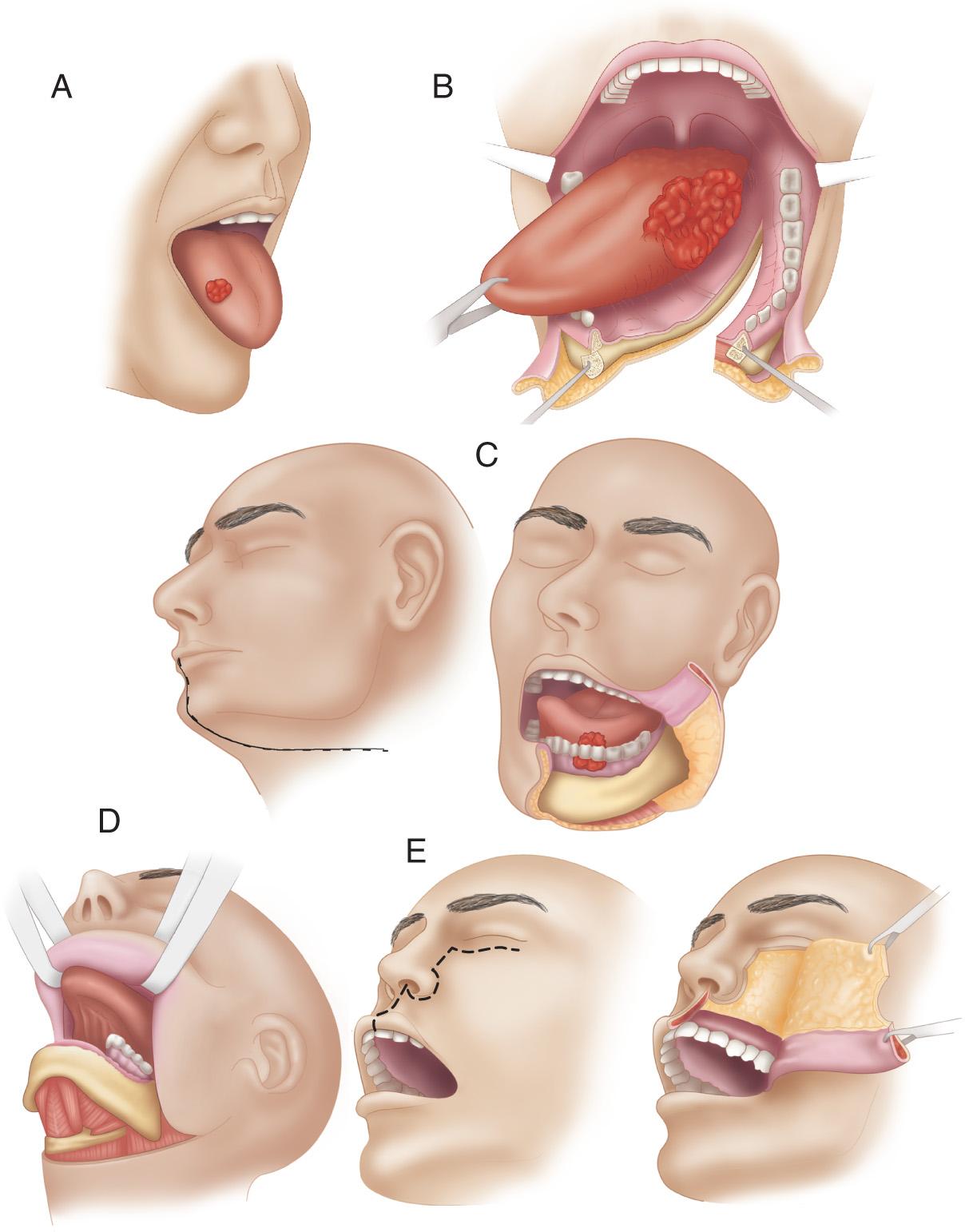
The peroral approach can be safely used for small, anteriorly located, and easily accessible tumors of the oral tongue, floor of mouth, gum, cheek mucosa, and hard or soft palate. Small but deeply infiltrating tumors may not be adequately resectable through the open mouth. Proximity of the tumor to the mandible or maxilla may influence the surgical approach even for small tumors.
When the peroral approach does not offer adequate exposure, the visor flap or cheek flap approaches (upper or lower) become necessary. The visor flap approach provides sufficient exposure for anteriorly located lesions but is not satisfactory for tumors located in the posterior oral cavity. The benefit of this approach is that it avoids a lower lip–splitting incision but produces permanent numbness of the chin because the mental nerves need to be transected for adequate mobilization of the flap. It also may cause sagging of the lower lip and drooling because of a loss of support and sensation. Thus its utility is limited. The lower cheek flap approach requires a midline lip–splitting incision that is continued laterally into the neck for exposure and neck dissection. This approach provides excellent exposure for nearly all tumors of the oral cavity except those of the upper gum and hard palate. Mandible resection (marginal or segmental) and reconstruction require the lower cheek flap approach in most instances. The lower cheek flap approach is required for marginal or segmental mandibulectomy of tumors adjacent to the body of the mandible. The upper cheek flap approach (the Weber-Ferguson incision and its modifications; see Chapter 5 ) is required for resection of larger tumors of the hard palate and upper alveolus, particularly if they are posteriorly located.
Access to larger tumors of the tongue, particularly those closer to the base of the tongue where the mandible is not involved, requires wider exposure for resection. A mandibulotomy or mandibular osteotomy is an excellent mandible-sparing surgical approach designed to gain access to the oral cavity or oropharynx for resection of primary tumors otherwise not accessible through the open mouth or by the lower cheek flap approach ( Fig. 8.58 ). The mandibulotomy can be performed in one of three locations: (1) lateral (through the body or angle of the mandible); (2) midline; or (3) paramedian.
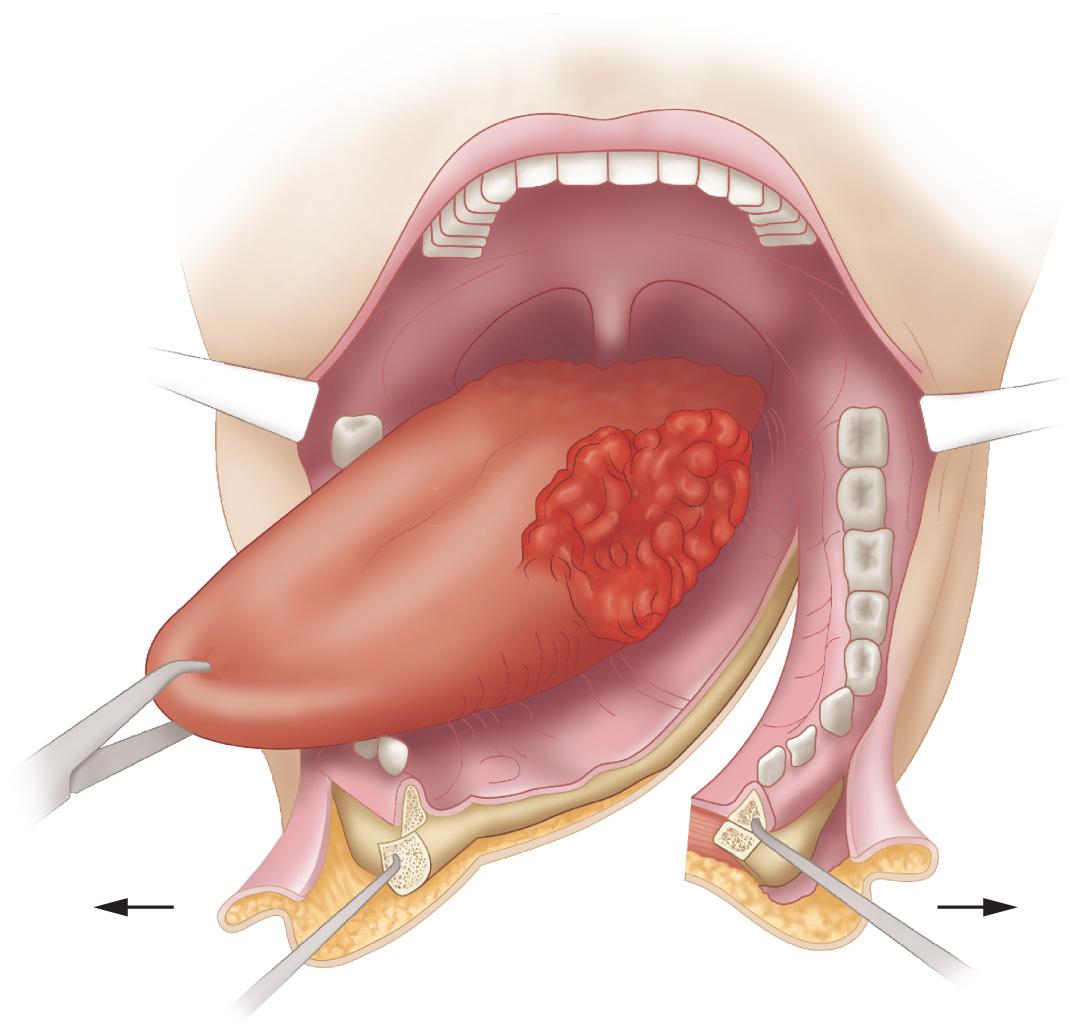
A lateral mandibulotomy has several disadvantages. First, the muscular pull on the two segments of the mandible is unequal, putting the mandibulotomy site under significant stress and causing a delay in healing. For this reason, intermaxillary fixation may be required. Second, the ability to gain access to the suture line to maintain cleanliness following surgery in the oral cavity is hampered as a result of intermaxillary fixation, leading to poor oral hygiene and the potential risk for sepsis of the suture line. In addition, a lateral mandibulotomy poses several anatomic disadvantages including denervation of the teeth distal to the mandibulotomy site and the skin of the chin as a result of transection of the inferior alveolar nerve. A lateral mandibulotomy also causes devascularization of the distal teeth and the distal segment of the mandible from its endosteal blood supply. The exposure provided by a lateral mandibulotomy is limited, and if the patient needs postoperative radiation therapy, delayed healing can lead to complications at the site of the mandibulotomy. For these reasons, a lateral mandibulotomy is not recommended.
By placing the mandibulotomy in the anterior midline, all the disadvantages of a lateral mandibulotomy are avoided. However, splitting the mandible in the midline requires extraction of one central incisor tooth to avoid exposure of the roots of both central incisor teeth, which are at risk of extrusion. Extraction of one central incisor tooth alters the aesthetic appearance of the lower dentition. In addition, a midline mandibulotomy requires division of muscles arising from the genial tubercle, that is, the geniohyoid and genioglossus, leading to a delayed recovery of the functions of mastication and swallowing. Therefore a median mandibulotomy also is not preferred for these reasons.
A paramedian mandibulotomy, on the other hand, avoids all the disadvantages of a lateral mandibulotomy and the sequelae of a midline mandibulotomy. It offers significant advantages, such as wide exposure and preservation of the geniohyoid and genioglossus muscles, leading to preservation of the hyomandibular complex. The only muscle requiring division is the mylohyoid muscle, which leads to minimal swallowing difficulties. A paramedian mandibulotomy does not cause denervation or devascularization of the skin of the chin or the teeth and mandible. Fixation at the mandibulotomy site is easy, and the site of the mandibulotomy is able to withstand radiation therapy if the patient needs postoperative treatment. Thus at present a paramedian mandibulotomy remains an optimal surgical approach for access to posteriorly located larger lesions of the oral cavity and tumors of the oropharynx and parapharyngeal space. Alternatively, posteriorly located lesions of the tongue and those of the oropharynx can be approached transorally with robotic instrumentation, without mandibulotomy, and thus avoid its morbidity.
Transoral robotic-assisted surgical resection is now commonly employed in lieu of mandibulotomy for surgical resection of patients with primary tumors arising from the base of the tongue. TORS may be used for accessing the posterior limit of a posteriorly located oral tongue tumor that extends into the base of the tongue in combination with peroral excision with the goal of avoiding a mandibulotomy. However, this is difficult in practice, because the angulation and excursion of the robotic arms often does not allow adequate visualization and access to the dorsal surface of the posterior oral tongue. Moreover, even if surgical excision is accomplished, the plastic surgeon may not be able to adequately access the surgical defect for suturing a microvascular free flap. For these reasons, TORS should be used in very selected instances only by very experienced surgical teams that are not just familiar with resection techniques but also facile with suturing using the surgical robot.
Become a Clinical Tree membership for Full access and enjoy Unlimited articles
If you are a member. Log in here